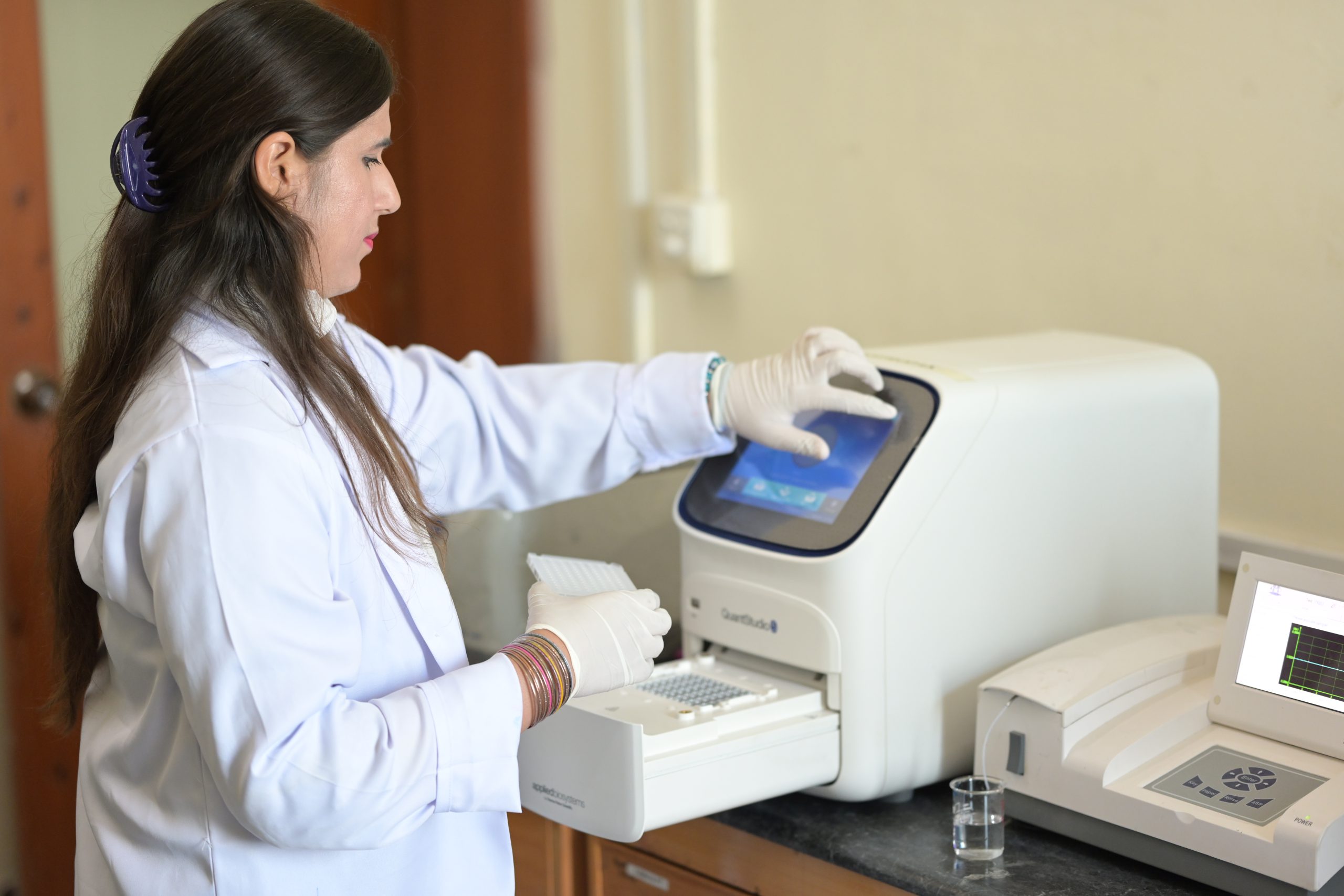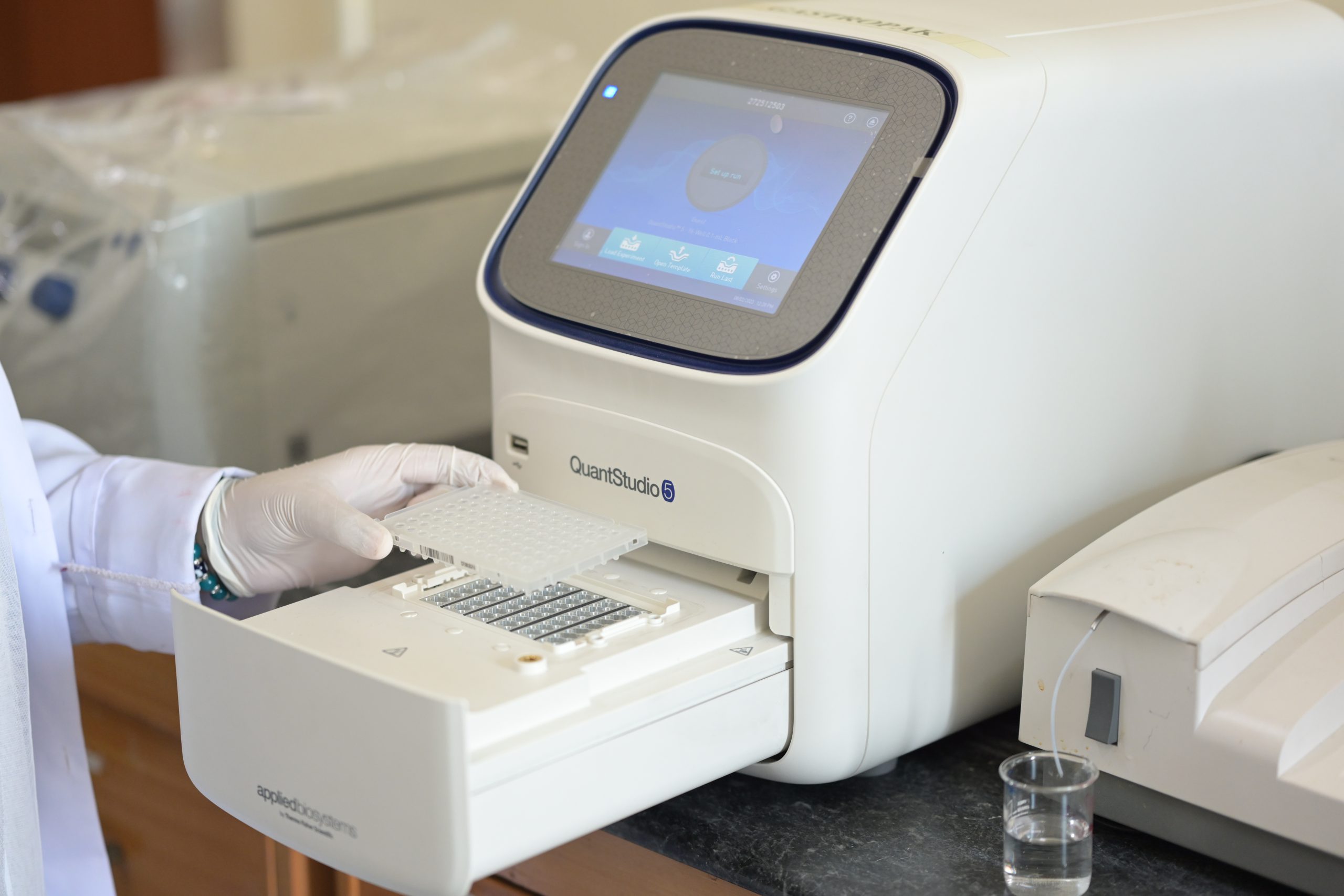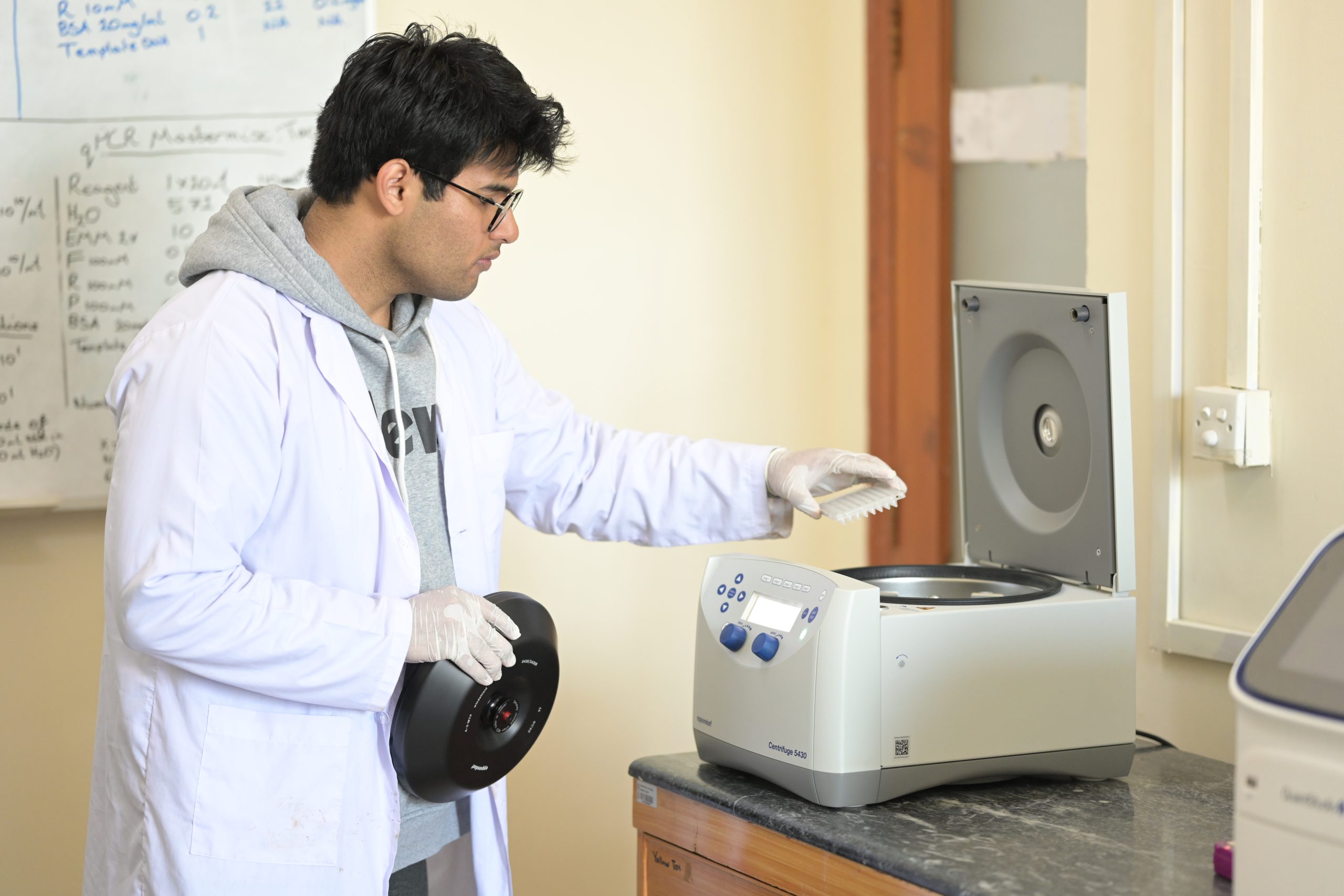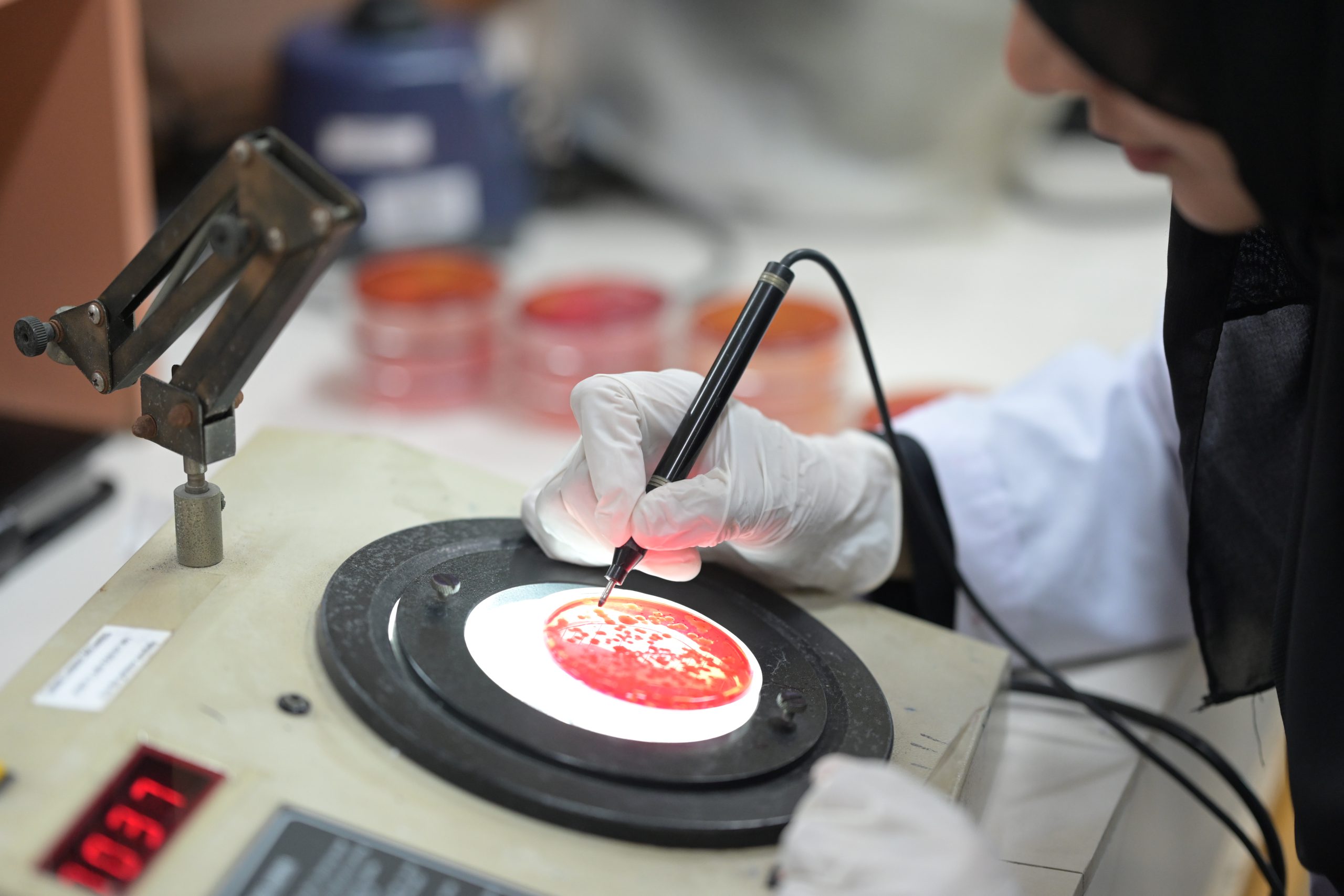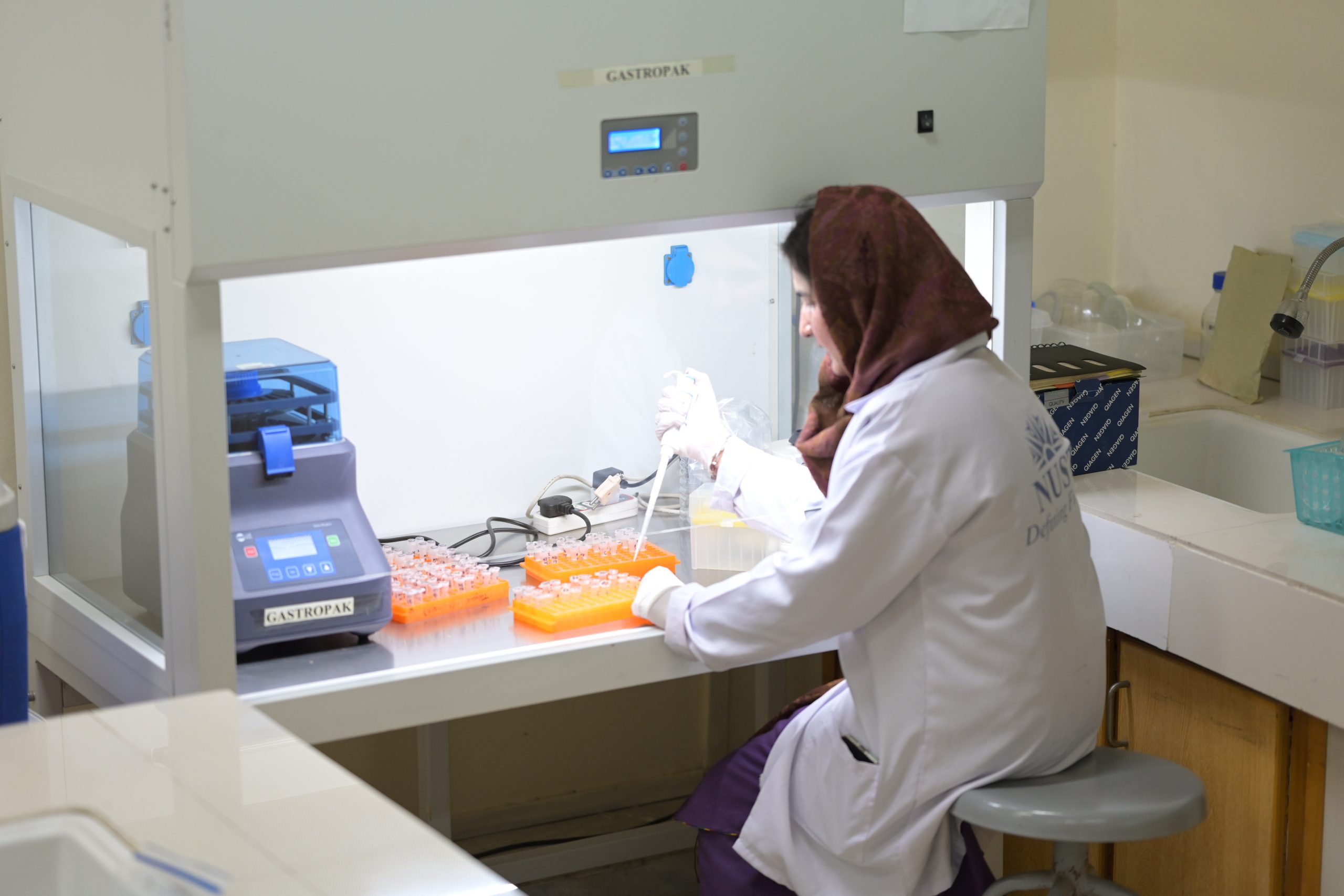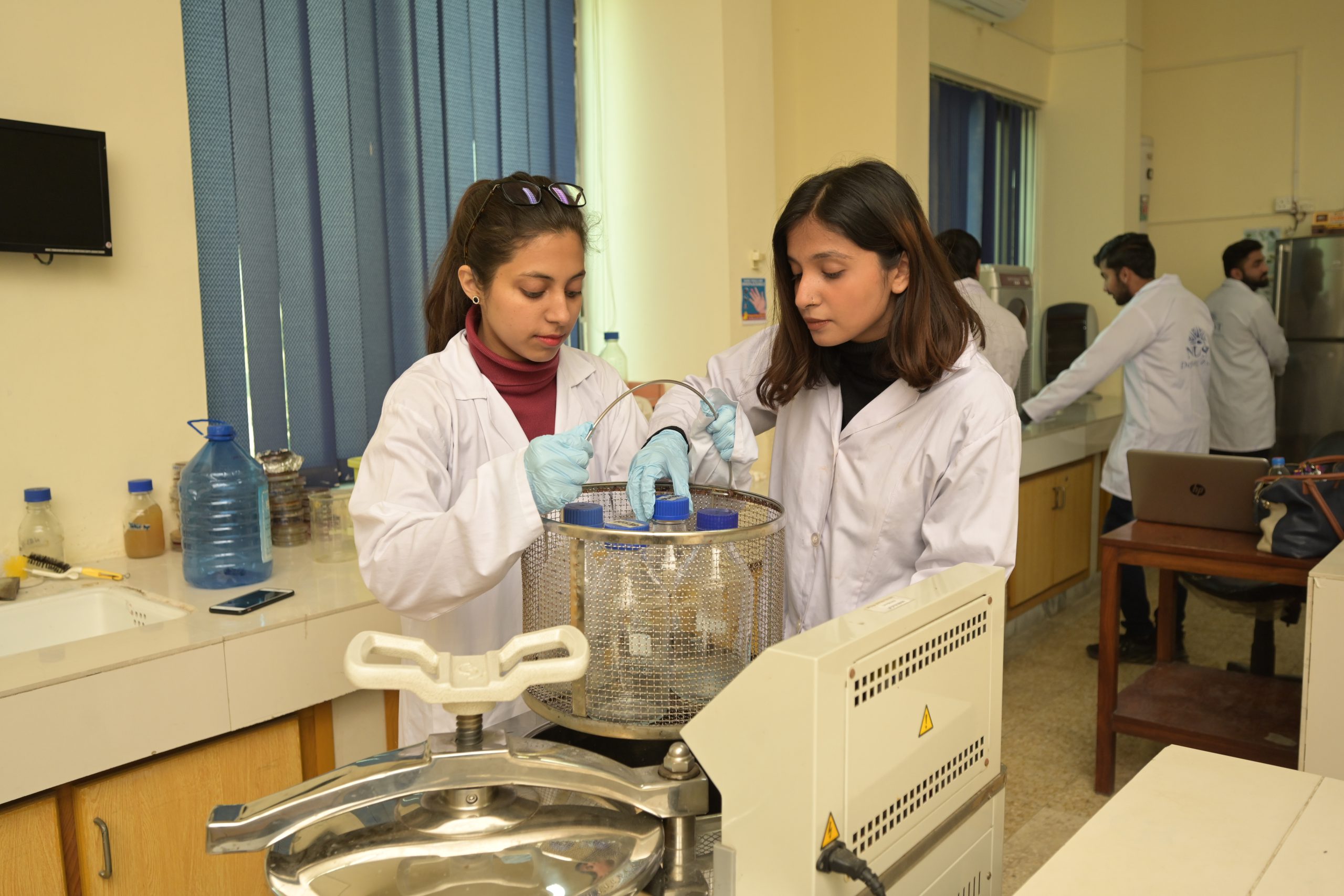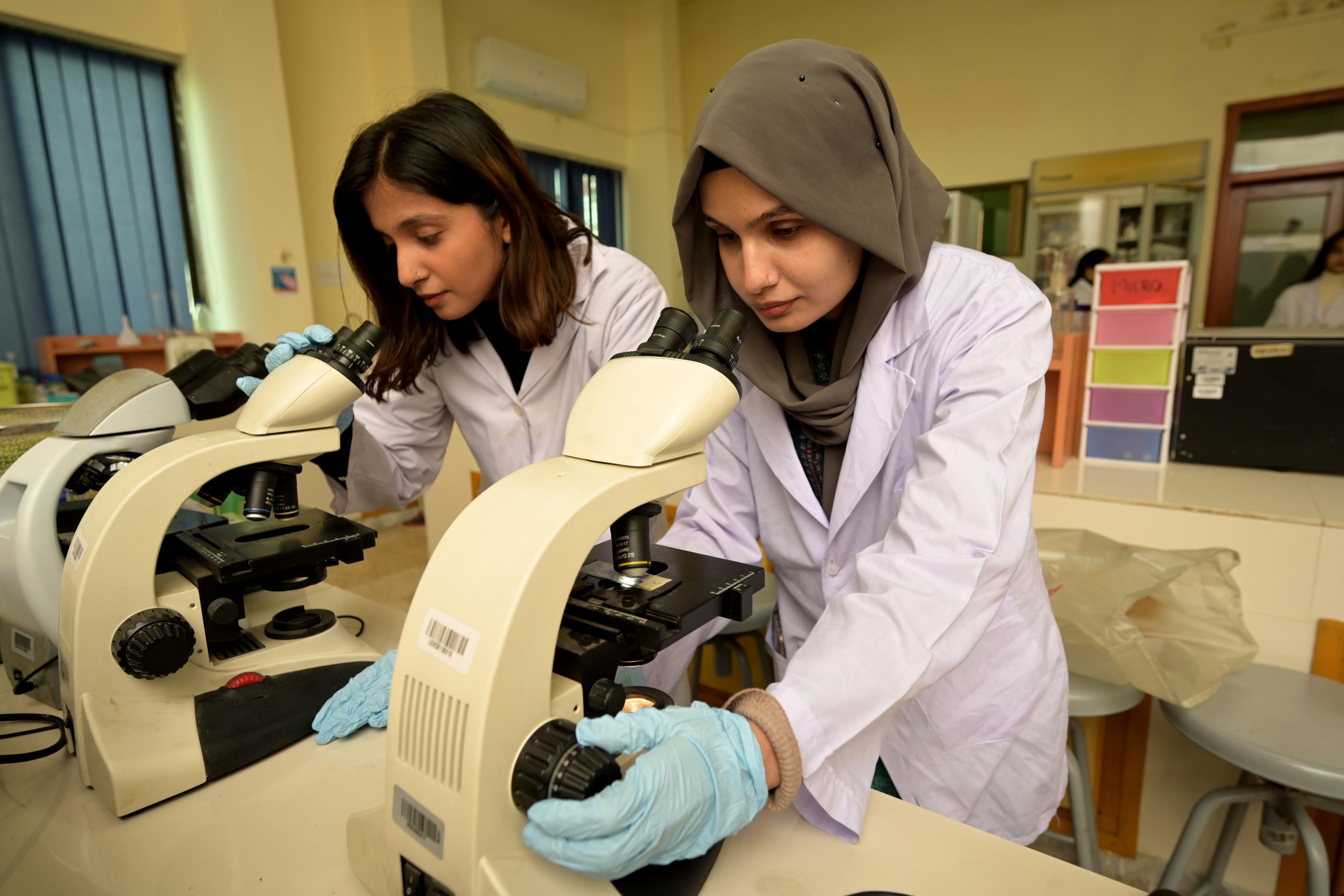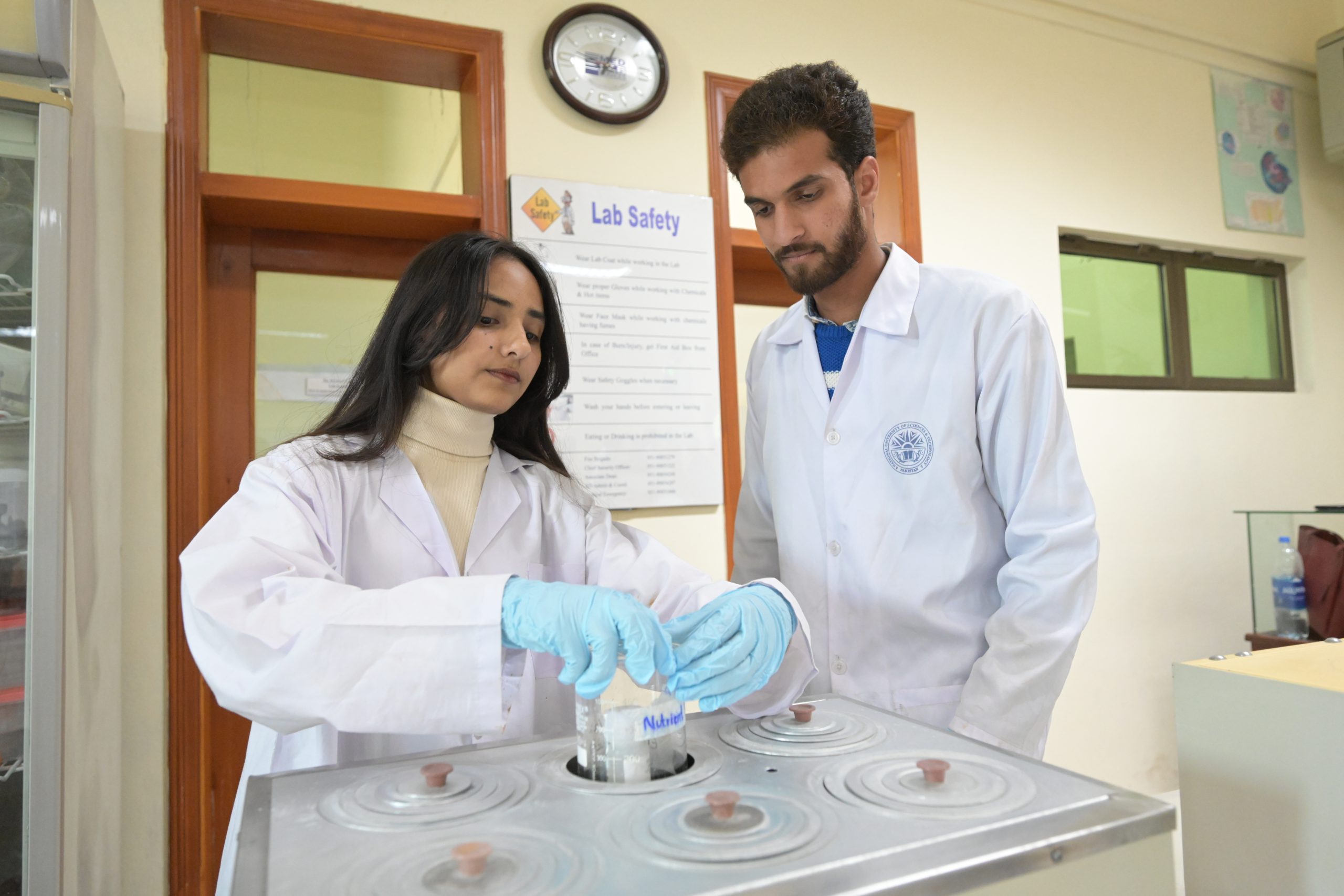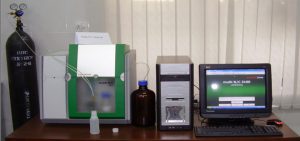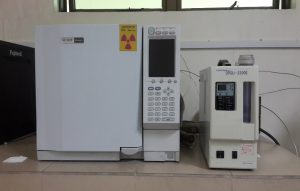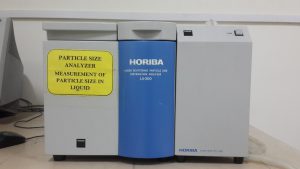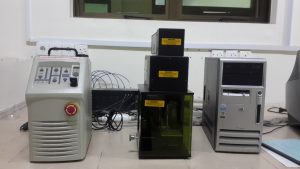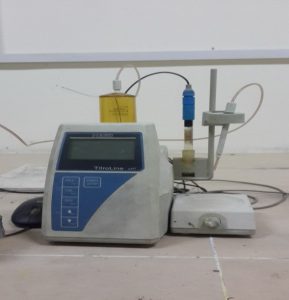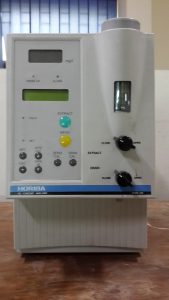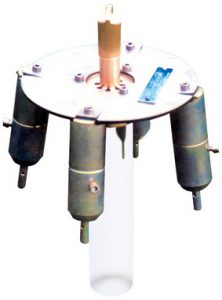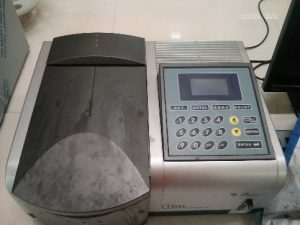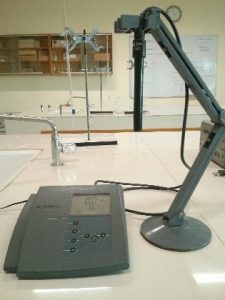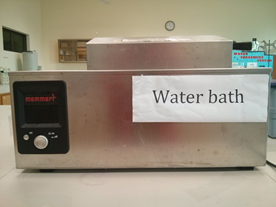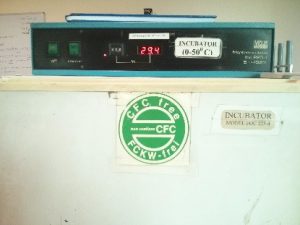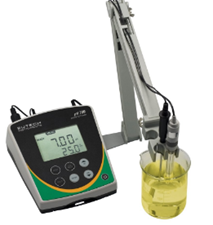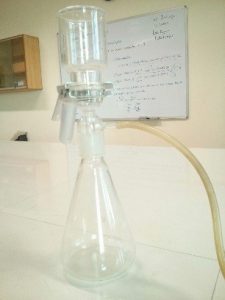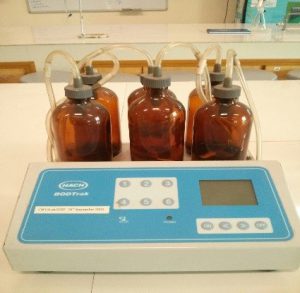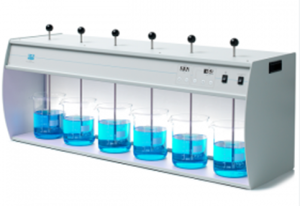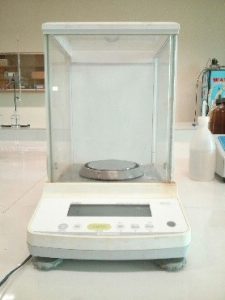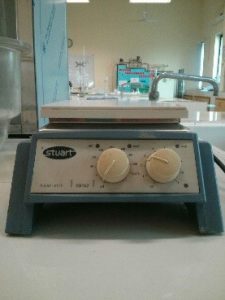Month: June 2020
Publications in Year 2019
1. Iqbal, A., Mushtaq, M. U., Khan, A. H. A., Nawaz, I., Yousaf, S., Zeshan & Iqbal, M. (2019). Influence of Pseudomonas japonica and organic amendments on the growth and metal tolerance of Celosia argentea L. Environmental Science and Pollution Research, 1-15.
2. Rajput, A.A., Zeshan. (2019). Effect of inoculum type and organic loading on biogas production of sunflower meal and wheat straw, Sustainable Environment Research, 29:4, 1-10.
3. Khalid, M.J., Zeshan, Waqas, A. and Nawaz I. (2019). Synergistic Effect of Alkaline Pretreatment and Magnetite Nanoparticle Application on Biogas Production from Rice Straw. Bioresource Technology, 275, 288-296.
4. Razzaq, M., Zeeshan, M., Qaisar, S., Iftikhar, H., & Muneer, B. (2019). Investigating use of metal-modified HZSM-5 catalyst to upgrade liquid yield in co-pyrolysis of wheat straw and polystyrene. Fuel, 257, 116119. (IF 5.12)
5. Muneer, B., Zeeshan, M., Qaisar, S., Razzaq, M., & Iftikhar, H. (2019). Influence of in-situ and ex-situ HZSM-5 catalyst on co-pyrolysis of corn stalk and polystyrene with a focus on liquid yield and quality. Journal of Cleaner Production, 237, 117762. (IF 6.395)
6. Iftikhar, H., Zeeshan, M., Iqbal, S., Muneer, B., & Razzaq, M. (2019). Co-pyrolysis of Sugarcane Bagasse and Polystyrene with ex-situ catalytic bed of Metal Oxides/HZSM-5 with focus on liquid yield. Bioresource Technology, 121647 (IF 6.669)
7. Asif, A., Zeeshan, M., & Jahanzaib, M. (2019). Assessment of indoor and outdoor microbial air quality of cafeterias of an educational institute. Atmospheric Pollution Research, 10(2), 531-536 (IF 2.15)
8. Muhammad Adnan, Sher Jamal Khan, Kamran Manzoor, Nicholas P. Hankins (2019) “Performance Evaluation of Fertilizer Draw Solutions for Forward Osmosis Membrane Bioreactor treating Domestic Wastewater”, Process Safety and Environmental Protection, 127, 133-140. IF 3.441
9. Zunaira Habib, Sher Jamal Khan, Nasir Mehmood Ahmad, Hafiz Muhammad Aamir Shahzad, Yousuf Jamal, Imran Hashmi (2019) “Anti-bacterial Behavior of Surface Modified Composite Polyamide Nanofiltration (NF) Membrane by Immobilizing Ag doped TiO2 Nanoparticles”, Environmental Technology, In Press, Available online 23 May 2019. https://doi.org/10.1080/09593330.2019.1617355. IF 1.666
10. Alia Aslam, Sher Jamal Khan, Hafiz Muhammad Aamir Shahzad (2019) “Impact of sludge recirculation ratios on the performance of anaerobic membrane bioreactor for wastewater treatment”, Bioresource Technology, 288. 121473. IF 6.669
11. Rabia Shoukat, Sher Jamal Khan, Yousuf Jamal (2019) “Hybrid anaerobic-aerobic biological treatment for real textile wastewater”, Journal of Water Process Engineering, 29, 100804. IF 3.173
12. S. Jamal Khan, Ghalib Hasnain, Hasan Fareed, Roger Ben Aim (2019) “Evaluation of treatment performance of a full-scale membrane bioreactor (MBR) plant from unsteady to steady state condition”, Journal of Water Process Engineering, 30, 100379. IF 3.173
13. Muhammad Aamir Shahzad, Sher Jamal Khan, Muhammad Saboor Siddique (2019) “Draw solution recovery using direct contact membrane distillation (DCMD) from osmotic membrane bioreactor (Os-MBR)”, Journal of Water Process Engineering, 30, 100484. IF 3.173
14. Maham Khan, Sher Jamal Khan, Shadi W. Hasan (2019) “Quorum sensing control and wastewater treatment in quorum quenching/ submerged membrane electro-bioreactor (SMEBR(QQ)) hybrid system”, Biomass and Bioenergy, Accepted. IF 3.537
15. Muhammad SaqibNawaz, Fozia Parveen, Sher Jamal Khan, Nicholas P. Hankins (2019) “Impact of osmotic backwashing, particle size distribution and feed-side cross-flow velocity on flux in the forward osmosis membrane bioreactor (FO-MBR)”, Journal of Water Process Engineering, 31, 100861. IF 3.173
16. U. Qureshi, B. Imtiaz, Y. Jamal, 2019 Synthesizing PET and food waste into refuse plastic fuel (RPF): Optimization and kinetic modeling. Journal of Thermal Analysis and Calorimetry. doi: 10.1007/s10973-019-08934-x
17. N. Maqbool, Z. Saleem, Y. Jamal, 2019 A Short Review on Reverse Osmosis Membranes: Fouling and Control. Open Access Journal of Waste Management & Xenobiotics 2(2) doi: 10.23880/oajwx-16000122
18. Maqbool, N., Khan, A., Malik, A. and Rasool, K. 2019. “Magnetic Nanoparticles for Chromium Removal from Industrial Wastewater.” 2nd International Conference on Sustainable Development in Civil Engineering, Pakistan (Accepted)
19. Rizwan Khan, Muhammad Ali Inam, Muhammad Akram, Ahmed Uddin, Sarfaraz Khan, Ick Tae Yeom: Effect of Dissolved Organic Matter on Agglomeration and Removal of CuO Nanoparticles by Coagulation. Processes. Processes 2019, 7(7), 455; https://doi.org/10.3390/pr7070455 (SCIE: 1.963)
20. Muhammad Ali Inam, Rizwan Khan, Muhammad Akram, Sarfaraz Khan, Ick Tae Yeom: Effect of Water Chemistry on Antimony Removal by Chemical Coagulation: Implications of ζ-Potential and Size of Precipitates. International Journal of Molecular Sciences 06/2019; 20(12):2945., DOI:10.3390/ijms20122945 (SCIE: 4.123)
21. Rizwan Khan, Muhammad Ali Inam, Saba Zam Zam, Muhammad Akram, Sookyo Shin, Ick Tae Yeom: Coagulation and Dissolution of CuO Nanoparticles in the Presence of Dissolved Organic Matter Under Different pH Values. Sustainability 05/2019; 11(10):2825., DOI:10.3390/su11102825 (SCIE: 2.075)
22. Muhammad Ali Inam, Rizwan Khan, Muhammad Akram, Sarfaraz Khan, Du Ri Park, Ick Tae Yeom: Interaction of Arsenic Species with Organic Ligands: Competitive Removal from Water by Coagulation-Flocculation-Sedimentation (C/F/S). Molecules 04/2019; 24(8):1619., DOI:10.3390/molecules24081619 (SCIE: 3.098)
23. Rizwan Khan, Muhammad Ali Inam, Sarfaraz Khan, Andrea Navarro Jiménez, Du Ri Park, Ick Tae Yeom: The Influence of Ionic and Nonionic Surfactants on the Colloidal Stability and Removal of CuO Nanoparticles from Water by Chemical Coagulation. International Journal of Environmental Research and Public Health 04/2019; 16(7):1260., DOI:10.3390/ijerph16071260 (SCIE: 2.145)
24. Muhammad Ali Inam, Rizwan Khan, Du Park, Sarfaraz Khan, Ahmed Uddin, Ick Yeom: Complexation of Antimony with Natural Organic Matter: Performance Evaluation during Coagulation-Flocculation Process. International Journal of Environmental Research and Public Health 03/2019; 16(7):1092., DOI:10.3390/ijerph16071092 (SCIE: 2.145)
25. Rizwan Khan, Muhammad Ali Inam, Sarfaraz Khan, Du Park, Ick Yeom: Interaction between Persistent Organic Pollutants and ZnO NPs in Synthetic and Natural Waters. Nanomaterials 03/2019; 9(3):472., DOI:10.3390/nano9030472 (SCIE: 3.504)
26. Rizwan Khan, Muhammad Ali Inam, Du Ri Park, Sarfaraz Khan, Muhammad Akram, Ick Tae Yeom: The Removal of CuO Nanoparticles from Water by Conventional Treatment C/F/S: The Effect of pH and Natural Organic Matter. Molecules 03/2019; 24(5):914., DOI:10.3390/molecules24050914 (SCIE: 3.098)
27. Waqas Qamar Zaman, Wei Sun, Muhammad Tariq, Zhenhua Zhou, Usman Farooq, Zain Abbas, Limei Cao, Ji Yang. Iridium Substitution in Nickel Cobaltite Renders High Mass Specific OER Activity and Durability in Acidic Media. Applied Catalysis B Volume 244, 5 May 2019, Pages 295-302.
28. Zain ul Abdeen, Mujeeb ur Rehman, “A numerical method for solving fractional differential equations, Engineering Computation, Vol. 36, No. 2, pp-551-568, 2019. https://doi.org/10.1108/EC-07-2018-0302
29. Hina K, Abbas M, Hussain Q, Arshad M, Ali S, Rizwan M. 2019. Investigation into arsenic retention in arid contaminated soils with biochar application. Arabian Journal of Geosciences. DOI: 10.1007/s12517-019-4865-3. IF 1.141
30. Iqbal A, Mukherjee M, Rashid J, Khan SA, Ali MA, Arshad M*. 2019. Development of plant-microbe phytoremediation system for petroleum hydrocarbon degradation: An insight from alk b gene expression and phytotoxicity analysis. Sci Total Environ. 671, 696-704. IF 5.589
31. Manzoor M, Gul I, Kallerhoff J, Arshad M*. 2019. Fungi-assisted phytoextraction of lead: tolerance, plant growth–promoting activities and phytoavailability. Environ Sci Pollut Res, https://doi.org/10.1007/s11356-019-05656-3. IF 2.914
32. Zahra Z, Maqbool T, Arshad M, Badshah MA, Choi HK, Hur J. 2019. Changes in fluorescent dissolved organic matter and their association with phytoavailable phosphorus in soil amended with TiO2 nanoparticles. Chemosphere 227, 17-25. IF 5.108
33. Rizwan M, Ali S, Ali B, Adrees M, Arshad M, Hussain A, Rehman MZ, Waris AA. 2019. Zinc and iron oxide nanoparticles improved the plant growth and reduced the oxidative stress and cadmium concentration in wheat. Chemosphere 214, 269-277. IF 5.108
34. Gul I, Manzoor M, Hashim N, Yaqoob K, Kallerhoff J, Arshad M*. 2019. Comparative effectiveness of organic and inorganic amendments on cadmium bioavailability and uptake by Pelargonium hortorum. J Soils Sediments. 19, 2346–2356. IF 2.669
35. Gul I, Manzoor M, Silvestre J, Rizwan M, Hina K, Kallerhoff J, Arshad M*. 2019. EDTA−Assisted phytoextraction of lead and cadmium by pelargonium cultivars grown on spiked soil. Int J Phytorem, 21, 101-110. IF 2.237
36. Zahra Z, Ali MA, Parveen A, Kim E, Khokhar MF, Baig S, Choi HK, Arshad M*. 2019. Exposure–response of wheat cultivars to TiO2 nanoparticles in contrasted soils. Soil Sediment Contam. 28, 184-199. IF 0. 992
37. Iqbal A, Arshad M*, Karthikiyan R, Gentry TJ, Rashid J, Ahmed I, Schwab AP. 2019. Diesel degrading bacterial endophytes with plant growth promoting potential isolated from a petroleum storage facility. 3 Biotech, 9(1).35. DOI:https://doi.org/10.1007/s13205-018-1561-z. IF 1.786
38. Rizwan M, Ali S, Rehman MZ, Adrees M, Arshad M, Qayyum MF, Ali L, Hussain A, Chatha SAS, Imran M. 2019. Alleviation of cadmium accumulation in maize (Zea mays L.) by foliar spray of zinc oxide nanoparticles and biochar to contaminated soil. Environ Pollut, 248, 358-367. IF 5.714
39. Manzoor M, Abid R, Rathinasabapathi B, De Oliveira LM, da Silva E, Deng F, Rensing C, Arshad M, Gul I, Xiang P, Ma LQ. 2019. Metal tolerance of Arsenic-resistant bacteria and Their potential to promote plant growth in Pb-contaminated soil. Sci Total Environ, 660, 18-24. IF 5.589
40. Hina K, Kanwal SS, Arshad M, Gul I. 2019. Effect of cadmium (Cd) stress of spinach (Spinacea pleracea) and its retention kinetics in soil in response to organic amendments. Pak J Agric Sci. 56, 179-185. IF 0.618
41. S Kanwal, S Baig, I Hashmi, carbon storage and allocation pattern in plant biomass under drought stress and nitrogen supply in eucalyptus camaldulensis and populus deltoides, (2019) pakistan journal of botany 51 (5), 1605-1614
42. I Gul, M Manzoor, I Hashmi, MF Bhatti, J Kallerhoff, M Arshad, Plant uptake and leaching potential upon application of amendments in soils spiked with heavy metals (Cd and Pb) (2019) Journal of Environmental Management 249, 109408
43. S Perveen, I Hashmi, R Khan, Evaluation of genotoxicity and hematological effects in common carp (Cyprinus carpio) induced by disinfection by-products (2019) Journal of water and health 17 (5), 762-776
44. M Manzoor, I Gul, I Ahmed, M Zeeshan, I Hashmi, BAZ Amin, J Kallerhoff, Metal tolerant bacteria enhanced phytoextraction of lead by two accumulator ornamental species, (2019) Chemosphere 227, 561-569
45. M Khan, I Hashmi, Third Conference on Challenges and Possibilities for Environmental Sustainability with a Focus on Pakistan (2019)/The Effect of Pipe Material, Pipe Age, and Supply Patterns (2019) Lahore School of Economics
46. Jabeen, Z. MF. Khokhar. Extended database of SO2 column densities over Pakistan by exploiting satellite observations. Atmospheric Pollution Research, Feb 2019 (in press)
Publications in Year 2018
2. Khan, S. R., Zeeshan, M*., & Iqbal, S. (2018). Thermal management of newly developed non-noble metal-based catalytic converter to reduce cold start emissions of small internal combustion engine. Chemical Engineering Communications, 205(5), 680-688 (IF 1.29)
3. Aamir, E., Tariq, M., Khan, M. and Afzal, T. (2018). TREATMENT & RECYCLING OF GREY WATER FOR SUSTAINABLE WATER MANAGEMENT. In: 3rd International Conference on Emerging Trends in Engineering, Management & Sciences (ICETEMS-2018). [online] Peshawar: City University of Science & Information Technology (CUSIT), Peshawar – Pakistan, p.40. Available at: http://icetems.com/[Accessed 5 Dec. 2018].
4. Aamir, E., Hassan, I., (2018).”TREND ANALYSIS IN PRECIPITATION AT INDIVIDUAL AND REGIONAL LEVELS IN BALOCHISTAN, PAKISTAN” In: 1 IOP conference series :Materials Sciences and Engineering, volume 414,conference 1
5. Tariq, M., Aamir, E., et al (2018).”EXPLORING ADOPTION OF INTEGRATED BUILDING INFORMATION MODELLING AND VIRTUAL REALITY” In: Proc. of the 1st International Conference on Electrical, Communication and Computer Engineering (ICECCE).
6. Sher Jamal Khan, Muhammad Saboor Siddique, Hafiz Muhammad Aamir Shahzad (2018) “Performance Evaluation of Hybrid OMBR-MD Using Organic and Inorganic Draw Solutions”, Water Science & Technology, 78, 776-785. IF 1.247
7. Ammara Haider, Sher Jamal Khan, Muhammad Saqib Nawaz, Muhammad Usman Saleem (2018) “Effect of intermittent operation of lab scale upflow anaerobic sludge blanket (UASB) reactor on textile wastewater treatment”, Desalination and Water Treatment, 136, 120-130. IF 1.631
8. J. W. Lee, S. J. Lee, Y. Jamal, Y. Yun, 2018 Partial slagging coal gasifier operational performance and product characteristics for energy sustainability in an integrated gasification combined cycle system. Journal of the Energy Institute doi: 10.1016/j.joei.2017.05.004
9. Rizwan Khan, Muhammad Ali Inam, Muhammad Mazhar Iqbal, Muhammad Shoaib, Du Ri Park, Kang Hoon Lee, Sookyo Shin, Sarfaraz Khan, Ick Tae Yeom: Removal of ZnO Nanoparticles from Natural Waters by Coagulation- Flocculation Process: Influence of Surfactant Type on Aggregation, Dissolution and Colloidal Stability. Sustainability 12/2018; 11(1):17., DOI:10.3390/su11010017(SCIE: 2.075)
10. Muhammad Ali Inam, Rizwan Khan, Du Ri Park, Babar Aijaz Ali, Ahmed Uddin, Ick Tae Yeom: Influence of pH and Contaminant Redox Form on the Competitive Removal of Arsenic and Antimony from Aqueous Media by Coagulation. Minerals 12/2018; 8(12):574., DOI:10.3390/min8120574 (SCIE: 1.835)
11. Rizwan Khan, Muhammad Ali Inam, Du Park, Saba Zam Zam, Sookyo Shin, Sarfaraz Khan, Muhammad Akram, Ick Tae Yeom: Influence of Organic Ligands on the Colloidal Stability and Removal of ZnO Nanoparticles from Synthetic Waters by Coagulation. Processes 09/2018; 6(9):170.,DOI:10.3390/pr6090170 (SCIE: 1.279)
12. Rizwan Khan, Muhammad Ali Inam, Du Ri Park, Saba Zam Zam, Ick Tae Yeom: Taguchi Orthogonal Array Dataset for the Effect of Water Chemistry on Aggregation of ZnO Nanoparticles. 06/2018; 3(2):21., DOI:10.3390/data3020021 (ESCI)
13. Rizwan Khan, Muhammad Ali Inam, Saba Zam, Du Park, Ick Yeom: Assessment of Key Environmental Factors Influencing the Sedimentation and Aggregation Behavior of Zinc Oxide Nanoparticles in Aquatic Environment. Water 05/2018; 10(5):660., DOI:10.3390/w10050660 (SCIE: 2.069)
14. Muhammad Ali Inam, Rizwan Khan, Du Ri Park, Yong-Woo Lee, Ick Tae Yeom: Removal of Sb(III) and Sb(V) by Ferric Chloride Coagulation: Implications of Fe Solubility. Water 04/2018; 10(4):418., DOI:10.3390/w10040418 (SCIE: 2.069)
15. Waqas Qamar Zaman, Wei Sun, Zhen-hua Zhou, Yiyi Wu, Limei Cao, Ji Yang. Anchoring of Trace IrO2 on 1-D Co3O4 Nano-rods for Robust Electrocatalytic Water Splitting in an Acidic Environment. ACS Appl. Energy Mater.2018, 1, 6374−6380.
16. Zhenhua Zhou, Waqas Qamar Zaman, Wei Sun, Li-mei Cao, Muhammad Tariq and Ji Yang. Cultivating crystal lattice distortion in IrO2 via coupling with MnO2 to boost the oxygen evolution reaction with high intrinsic activity. Chem. Commun., 2018, 54, 4959-4962.
17. Muhammad Tariq, Waqas Qamar Zaman, Wei Sun, Zhenhua Zhou, Yiyi Wu, Li-mei Cao, and Ji Yang. Unraveling the Beneficial Electrochemistry of IrO2/MoO3 Hybrid as a Highly Stable and Efficient Oxygen Evolution Reaction Catalyst. ACS Sustainable Chem. Eng. 2018, 6, 4854 – 4862.
18. Nauman Anwar Baig, M. Anwar Baig, T. A. Baig, A. A. Baig and A.A. Baig (2018 ) Estimation of Phase Range, Doppler of Targets Using Maximum Likelihood Estimator. K. Arai et al (Eds) FTC, AISC 881, pp. 483-490. Doi.org/10.1007/978-3-030-02683-7_34
19. Muhammad Anwar Baig “Are we drinking Quality and Safe Water in Pakistan”. World Environment Day held on Saturday 23rd June -2018 Pakistan Engineering Congress 97-A/D-1, 4th Floor, PEC Building, Liberty Market, Gulberg-III Lahore-54660
20. R Khan, I Hashmi, H Nasir, S Rasheed, LC Campos, Incidence of chlorination by-products in an institutional drinking water distribution network, Islamabad, Pakistan, using response surface methodology (2018) Journal of Water, Sanitation and Hygiene for Development 8 (4), 740-751
21. S Khalid, JI Han, I Hashmi, G Hasnain, MA Ahmed, SJ Khan, M Arshad, Strengthening calcium alginate microspheres using polysulfone and its performance evaluation: Preparation, characterization and application for enhanced biodegradation (2018) Science of The Total Environment 631, 1046-1058
22. A Iqbal, M Arshad, I Hashmi, R Karthikeyan, TJ Gentry, AP Schwab, Biodegradation of phenol and benzene by endophytic bacterial strains isolated from refinery Wastewater-fed Cannabis sativa (2018) Environmental technology 39 (13), 1705-1714
23. S Pervez, SJ Khan, H Waheed, I Hashmi, CH Lee, Impact of quorum quenching bacteria on biofouling retardation in submerged membrane bioreactor (SMBR)(2018) Membrane Water Treatment 9 (4), 279-284
24. Y Xiao, H Waheed, K Xiao, I Hashmi, Y Zhou, In tandem effects of activated carbon and quorum quenching on fouling control and simultaneous removal of pharmaceutical compounds in membrane bioreactors (2018) Chemical Engineering Journal 341, 610-617
25. A Asif, M Zeeshan, I Hashmi, U Zahid, MF Bhatti, Microbial quality assessment of indoor air in a large hospital building during winter and spring seasons (2018) Building and Environment 135, 68-73
26. H Waheed, S Pervez, I Hashmi, SJ Khan, SR Kim, High-performing antifouling bacterial consortium for submerged membrane bioreactor treating synthetic wastewater (2018) International journal of environmental science and technology 15 (2), 395-404
27. Romana Khan, Imran Hashmi, Habib Nasir, Sajida Rasheed, Luiza C Campos (2018) Incidence of chlorination by-products in an institutional drinking water distribution network, Islamabad, Pakistan, using response surface methodology. Journal of Water, Sanitation and Hygiene for Development 8(4) 740-751. Impact factor: 0.785
28. Saimar Pervez, Sher Jamal Khan, Hira Waheed, Imran Hashmi, Chung-Hak Lee (2018) Impact of quorum quenching bacteria on biofouling retardation in submerged membrane bioreactor (SMBR), Membrane Water Treatment; 9(4);279-284. Impact Factor: 0.50
29. Saira Khalid, Jong-In Han, Imran Hashmi, Ghalib Hasnain, Muhammad Ajaz Ahmed, Sher Jamal Khan & Muhammad Arshad (2018) Strengthening calcium alginate microspheres using polysulfone and its performance evaluation: Preparation, characterisation and application for enhanced biodegradation of chlorpyrifos. Science of The Total Environment, 631: 1046-1058.
30. Ayesha Asif, Muhammad Zeeshan, Imran Hashmi, Uzma Zahid & Muhammad Faraz Bhatti (2018) Microbial quality assessment of indoor air in a large hospital building during winter and spring seasons. Building and Environment. 135: 68-73.
31. Zeb N, MF Khokhar, Pozzer A, Khan SA. Exploring the temporal trends and seasonal behaviour of tropospheric trace gases over Pakistan by exploiting satellite observations. Atmospheric Environment. 2018 Nov 2.Volume 198, 1 February 2019, Pages 279-290
32. Anwar MN, Fayyaz A, Sohail NF, Khokhar MF, Baqar M, Khan WD, Rasool K, Rehan M, Nizami AS. CO2 capture and storage: A way forward for sustainable environment. Journal of environmental management. 2018 Nov 15;226:131-44.
33. Murtaza R., M.F. Khokhar, N. Zeb, A. Noreen, KR Hakeem: Multi-Sensor Temporal Assessment of Tropospheric Nitrogen Dioxide Column Densities over Pakistan, Environ Sci Pollut Res, https://doi.org/10.1007/s11356-017-1176-7, 2018
34. Noreen, A., Khokhar, MF., Zeb, N.Yasmin N, Hakeem KR. Spatio-temporal assessment and seasonal variation of tropospheric ozone in Pakistan during the last decade. Environ Sci Pollut Res (2018). https://doi.org/10.1007/s11356-017-1010-2, 2018
35. Rajput, A.A., Zeshan, Visvanathan, C. (2018). Effect of thermal pretreatment on chemical composition, physical structure and biogas production kinetics of wheat straw, Journal of Environmental Management, 221, 45-52.
36. Hussain, F., Hussain, I., Khan, A. H. A., Muhammad, Y. S., Iqbal, M., Soja, G., Reichenauer, T. G. Zeshan & Yousaf, S. (2018). Combined application of biochar, compost, and bacterial consortia with Italian ryegrass enhanced phytoremediation of petroleum hydrocarbon contaminated soil. Environmental and Experimental Botany, 153, 80-88.
37. Waqas, A., Ji, J., Bahadar, A., Xu, L., Zeshan, & Modjinou, M. (2018). Thermal management of conventional photovoltaic module using phase change materials – An experimental investigation. Energy Exploration & Exploitation, 0144598718795697.
38. Waqas, A., Ji, J., Xu, L., Ali, M., Zeshan & Alvi, J. (2018). Thermal and electrical management of photovoltaic panels using phase change materials–A review. Renewable and Sustainable Energy Reviews, 92, 254-271.
39. Rafique R, Baek SH, Park CY, Chang S-J, Gul AR, Ha S, Nguyen TP, Oh H, Ham S, Arshad M, Lee H, Park TJ. 2018. Morphological evolution of upconversion nanoparticles and their biomedical signal generation. Scientific Rep, 8:17101, DOI:10.1038/s41598-018-35513-1. IF 4.011
40. Rehman S, Adil A, Shaikh AJ, Shah JA, Arshad M, Ali MA, Bilal M. 2018. Role of sorption energy and chemisorption in batch methylene blue and Cu2+ adsorption by novel thuja cone carbon in binary component system: linear and nonlinear modeling. Environ Sci Pollut Res, 25, 31579-31592. IF 2.914
41. Zahra Z, Kim SY, Kim HY, Lee H, Lee H, Jeon JY, Kim DM, Kim DM, Hong SJ, Cho BK, Lee H, Lee CG, Arshad M, Choi HK. 2018. Phycobiliproteins production enhancement and lipidomic alteration by titanium dioxide nanoparticles in Synechocystis sp. PCC 6803 culture. J Agric Food Chem. 66 (32), 8522–8529. IF 3.571
42. Rafique R, Zahra Z, Virk N, Shahid M, Pinelli E, Park TJ, Kallerhoff J, Arshad M*. 2018. Dose-dependent physiological responses of Triticum aestivum L. to soil applied TiO2 nanoparticles: Alterations in chlorophyll content, H2O2 production, and genotoxicity. Agric Ecosyst Environ. 255, 95–101. IF 3.954
43. Manzoor M, Gul I, Silvestre J, Kallerhoff J, Arshad M*. 2018. Screening of indigenous ornamental species from different plant families for Pb accumulation potential exposed to metal gradient in spiked soils. Soil Sediment Contam, 27, 439–453. IF 0.992
44. Rashid S, Arshad M, Siddiqa M, Ahmad R. 2018. Evaluation of DNA damage in traffic police wardens of Pakistan due to cadmium and zinc. Sci Total Environ. 630, 1360–1364. IF 5.589
45. Rafique R, Zahra Z, Virk N, Shahid M, Pinelli E, Kallerhoff J, Park TJ, Arshad M. 2018. Data on rhizosphere pH, phosphorus uptake and wheat growthresponsesuponTiO2 nanoparticles application. 2018. Data Brief. 17, 890–896.
46. Abbas T, Rizwan M, Ali S, Adrees M, Mahmood A, Zia-Ur-Rehman M, Ibrahim M, Arshad M, Qayyum MF. 2018. Biochar application increased the growth and yield and reduced cadmium in drought stressed wheat grown in an aged contaminated soil. Ecotoxicol Environ Saf. 148, 825-833. IF 4.527
47. Iqbal A, Arshad M, Hashmi H, Karthikeyan R, Gentry TJ, Schwab, AP. 2018. Biodegradation of phenol and benzene by endophytic bacterial strains isolated from refinery wastewater-fed Cannabis sativa. Environ Technol, 39, 1705-1714. IF 1.918
Publications in Year 2017
2. J. W. Lee, S. J. Lee, Y. Jamal, Y. Yun, 2017 Partial slagging coal gasifier operational performance and product characteristics for energy sustainability in an integrated gasification combined cycle system. Journal of the Energy Institute doi: 10.1016/j.joei.2017.05.004
Publications in Year 2016
Publications in Year 2015
1. Arshad M, Siddiqa M, Rashid S, Hashmi I, Awan MA, Ali MA. 2016. Biomonitoring of toxic effects of pesticides in occupationally exposed individuals. Saf Health Work. 10.1016/j.shaw.2015.11.001.
2. Sidra, Abbas., Imran, Hashmi., Muhammad, Saif-Ur Rehman,. Ishtiaq, A. Qazi., Mohammad, A. Awan and Habib, Nasir. (2015) Monitoring of chlorination disinfection by-products and their associated health risks in drinking water of Pakistan Journal of Water and Health. 13(1): 270-284. doi:10.2166/wh.2014.096ISSN: 1477-8920: Impact factor: 1.22
3. Arshad M, Merlina G, Uzu G, Sobanska S, SarretG, Dumat C, Silvestre J, Pinelli E, Kallerhoff J. 2015. Phytoavailability of lead altered by two Pelargonium cultivars grown on contrasting lead-spiked soils. J Soils Sediments, DOI:10.1007/s11368-015-1248-6, IF 2.139
4. Zahid MS, Iqbal A, Arshad M. 2015. Benzene degradation with bacterial strains isolated from rhizosphere of Cannabis sativabeing irrigated with petroleum refinery wastewater. Desalin Water Treat, DOI: 10.1080/19443994.2015.1086896, IF 1.173
5. Zahra Z, Arshad M, Rafique R, Mahmood A, Habib A, Qazi IA, Khan SA. 2015. Metallic Nanoparticle (TiO2and Fe3O4) application modifies rhizosphere phosphorus availability and uptake by Lactuca sativa. J Agric Food Chem. 63, 6876-82, IF 2.912
6. Hanif HU, Arshad M, Ali MA, Ahmed N, Qazi IA. 2015. Phytoavailability of phosphorus to Lactuca sativain response to soil applied TiO2nanoparticles. Pak J Agri Sci, 52, 177-182, IF 1.049
7. Zafar M, Arshad M, Khokhar MF. 2015. Assessment of particulate matter (PM10) and polycyclic aromatic hydrocarbons levels at various sites in Faisalabad and their potential toxicity. Pak J Agri Sci, 52, 233-238, IF 1.049
8. Mehmood CT, Arshad M, Ashfaq T, Bilal M, Shafiq M, Hina K. 2015. Kinetics of adsorptive removal of Drimarene Brilliant Red from aqueous solution using untreated agricultural residues. Pak J Sci Ind Res Ser. A: Phys. Sci. V 59, in press.
9. Arshad M, Khalid R, Hina K, Ullah S, Ali MA. 2015. Cadmium removal by aquatic macrophyte (Nasturtium officinale) and potential for oil production from the biomass. Pak J Agri Agril Engg Vet Sci, 31, 1-13
10. Muhammad Daud, Zahiruddin Khan, Aisha Ashgar, M. Ihsan Danish, and Ishtiaq A. Qazi. Comparing and optimizing Nitrate adsorption from aqueous solution using Fe/Pt bimetallic nanoparticles and anion exchange resins, Journal of Nanotechnology, 2015
11. Aisha Asghar, Zahiruddin Khan, Nida Maqbool, Ishtiaq A. Qazi, and Muhammad Ali Awan Comparison of Adsorption Capability of Activated Carbon and Metal Doped TiO2 for Geosmin and 2-MIB Removal from Water, Journal of Nanomaterials, 2015, Article ID 479103, 11 pages, http://dx.doi.org/10.1155/2015/479103 (I.F. 1.64)
12. Mehmood CM, Qazi IA, Baig MA, Arshad M, Quddos A. 2015. Application of photodegraded polythene films for the treatment of Drimarene Brilliant Red (DBR) dye. Int Biodeter Biodegr, 102, 31-39, IF 2.131
13. Khokhar M. F., N. Fatima, N. Yasmin, S. Beirle, T. Wagner: “Detection of trends and seasonal variation in tropospheric Nitrogen Dioxide over Pakistan ” journal of aerosol and air quality research, Volume 15, No. 7, December 2015, Pages 2508-2524, doi: 10.4209/aaqr.2015.03.0157, 2015, (IF=2.39)
14. Khokhar M. F., T. Khalid, N. Yasmin. I. Desmedt: Spatio-Temporal analyses of formaldehyde over Pakistan by using SCIAMACHY and GOME-2 observations. Aerosol and Air Quality Research, Volume 15, No. 5, October 2015, Pages 1760-1773, 2015, (IF=2.39)
15. Abbas. J. M. F. Khokhar, M. Arshad: Monitoring Formaldehyde Concentration Over Islamabad Using Ground Based And Satellite Observations. Submitted to Journal of Space technology IST Vol.5 Issue No.1 ISSN 2077-3099 ( HEC recognized for “Y” category), ( in press) 2015.
16. Khan W. R. M. F. Khokhar, S. Munawwar, Yasmin N., M.N. Rajpar, Q. Panhawar: Assessing the context of REDD+ in Murree hills forest of Pakistan. Advances in Environmental Biology, 9(6) Special 2015, Pages: 15-20,ISSN-1995-0756, 2015
17. Shabbir, Y., M. F. Khokhar, R. Shaiganfar, T. Wagner: Spatial variance and assessment of nitrogen dioxide pollution in major cities of Pakistan along N5-highway”. Journal of environmental sciences. JES-D-15-00190R2,( accepted), 2015
18. Munawar Sana, Khokhar Fahim, Atif Salman. 2015. Reducing Emissions from Deforestation and Forest Degradation implementation in northern Pakistan. International Biodeterioration and Biodegradation Journal. Vol (102) pages 316-323, 10.1016/j.ibiod.2015.02.027, 2015.
19. Hamid Iqbal & M. A. Baig (2015) Characterization of first flush in urban highway runoffs. Vol. 14, No 1, 45-50.
20. Iqbal, H., M. A. Baig, Usman Hanif, Usman Ali, S.M. and Flurry, M. (2015). “Leaching of Metals, Organic Carbon, and Nutrients from Municipal Waste under Semi-Arid Conditions. 9(1): 187-196
21. Izhar Hussain Shah and Muhammad Zeeshan (2015). Estimation of Light duty vehicle emissions in Islamabad and climate co-benefits of improved emission standards implementation. Atmospheric Environment. DOI: 10.1016/j.atmosenv.2015.12.012
22. Maqbool, T., Jamal Khan, S., Waheed, H., Lee, C.H., Hashmi, I., Iqbal, H. (2015) “Membrane biofouling retardation and improved sludge characteristics using quorum quenching bacteria in submerged membrane bioreactor”, Journal of Membrane Science, 483, 75-83.
23. Shahzad, M., Jamal Khan, S., Paul, P. (2015) “Influence of Temperature on the Performance of a Full-Scale Activated Sludge Process Operated at Varying Solids Retention Times Whilst Treating Municipal Sewage”, Water, 7, 855-867. IF.1.291
24. Imran, B., Jamal Khan, S., Qazi, I.A., Arshad, M. (2015) “Removal and recovery of sodium hydroxide (NaOH) from industrial wastewater by two-stage diffusion dialysis (DD) and electrodialysis (ED) processes”, Desalination and Water Treatment, Accepted. IF 0.987
25. Ahmad, F., Jamal Khan, S., Jamal, Y., Kamran, H., Ahsan, A., Ahmad, M., Khan, A. (2015) “Desalination of brackish water using capacitive deionization (CDI) technology”, Desalination and Water Treatment, Accepted. IF 0.987
26. Aftab, B., Jamal Khan, S., Maqbool, T., Hankins, N.P. (2015) “High strength domestic wastewater treatment with submerged forward osmosis membrane bioreactor”, Water Science and Technology, Accepted. IF 1.212
27. Saba, B., Zaman, B., Mahmood, T., Jamal Khan, S. (2015) “Treatment of Wastewater with a High C/N Ratio in Sequencing Batch Bioreactor (SBBR) containing Biocarriers”, Environmental Engineering and Management Journal, Accepted. IF 1.258.
28. A. Saeed, I. Hashmi, H.R. Habibi, L.Yu, and G. Achari. (2015) Photocatalytic Degradation of 2,4-D and Transition of endocrine Disruptive Activity Using Transcriptome Based Bioassay in Zebrafish Embryos.International Journal of Environmental Science and Development (IJESD).6(2): 128-132.
29. S. Rasheed, I. Hashmi, Q. Zhou, J. K. Kim, and L.C. Campos (2015) Combating Accidental Microbial Episodes by Back-Ground Chlorine Residuals in a scaled-up Distribution Network (Rig) Usinga Central Composite Design (CCD). International Journal of Environmental Science and Development (IJESD).6(2): 122-127 ISSN: 2010-0264.
30. Hira Waheed , Imran Hashmi, Sher Jamal Khan, Sang Ryoung Kim, Muhammad Arshad, HabibNasir. (2015) Microbial population dynamics and profiling of quorum sensing agents in membrane bioreactor. International Biodeterioration and Biodegradation. doi:10.1016/j.ibiod.2015.12.014.
31. Sajida Rashid, Luiza. C. Campos, Jong, K. Kim, Qizhi Zhou, Imran Hashmi. (2015) Optimization of TTHMs and their precursors’ removal by granulated activated carbon (GAC) and sand dual media by response surface methodology (RSM). Water Science and Technology: Water Supply.DOI: 10.2166/ws.2015.175
32. Izhar Hussain Shah, Ghulam Murtaza Mastoi, Raza Hussain Shah, Zameer Ali Palh , Khalid Hussain Lashari, Muhammad Amin Qureshi and Amber Shah (2015). Prediction of running emission factors from passenger vehicles in an urban area using International Vehicle Emissions Model as a computational tool. Journal of Multidisciplinary Scientific Research 3(5), 17-21. (ISSN 2307-6976)
33. Abbas. J. M. F. Khokhar, M. Arshad: Monitoring Formaldehyde Concentration Over Islamabad Using Ground Based And Satellite Observations. Submitted to Journal of Space technology JST Vol.5 Issue No.1 ISSN 2077-3099 (HEC recognized for “Y” category), 2015.
34. Khan W. R. M. F. Khokhar, S. Munawwar, Yasmin N., M.N. Rajpar, Q. Panhawar: Assessing the context of REDD+ in Murree hills forest of Pakistan. Advances in Environmental Biology, 9(6) Special 2015, Pages: 15-20, ISSN-1995-0756, 2015
35. Nusrat Shaheen , Muhammad Anwar Baig , Muhammad Ahsan Mahboob , Saeed Akbar and Muhammad Fahim Khokar (2015). Application of Remote Sensing Technologies to detect the vegetation changes during past two decades in Islamabad, Pakistan Journal of Social Sciences Volume 4, Number 3. 2305-9249 ISSN (P): 2305-9494 Publisher: Centre of Excellence for Scientific & Research Journalism.
36. Muhammad Zeeshan, N. T. Kim Oanh (2015). Relationship of MISR component AODs with black carbon and other ground monitored particulate matter composition, Atmospheric Pollution Research, 6(1): 62-69.
37. Saira, Khalid. and Imran, Hashmi (2015) Biotreatment of chlorpyrifos in a bench scale bioreactor using Psychrobacteralimentarius T14. Environmental Technology, 37(3):316-25.
Publications in Year 2014
Publications in Year 2013
1. Y. Jamal et al., 2013 Sorption Kinetics, Thermodynamics, and Regeneration for Lipid Feedstock Deacidification Using a Mixed Bed Ion Exchange Resin. Journal of Food Process Engineering 37, 27–32.
2. Nawaz, S., Gadelha, G., Jamal Khan, S., Hankins, N. (2013) “Microbial Toxicity Effects of Reverse Transported Draw Solute in the Forward Osmosis Membrane Bioreactor (FO-MBR)”, Journal of Membrane Science, 429 (323-329) IF: 4.908
3. Jamal Khan, S., Ilyas, S., and Zohaib-Ur-Rehman (2013) “Impact of nitrogen loading rates on treatment performance of domestic wastewater and fouling propensity in submerged membrane bioreactor (MBR)”, Bioresource Technology, 141 (46-49) IF: 5.039
4. Jamal Khan, S., Ali, S., Visvanathan, C., and Pillay, V.L. (2013) “Membrane fouling characterization in membrane based septic tank”, Desalination and Water Treatment, 51 (6415-6419) IF 0.852
5. M. Ihsan Danish, Ishtiaq A. Qazi, Akif Zeb, Amir Habib, M. Ali Awan, and Zahiruddin Khan. Arsenic removal from aqueous solution using pure and metal doped Titania Nanoparticles coated on glass beads: Adsorption and Column studies, Journal of Nanomaterials, 2013, Article ID 873694, 17 pages, 2013. DOI:10.1155/2013/873694 (I.F. 1.64)
6. Saman, K., Ishtiaq, A. Q., Hashmi, I., Muhammad, A. A. and Sadaf, Z. Z. (2013) Synthesis of silver doped titanium TiO2 powder-coated surfaces and its ability to inactivate Pseudomonas aeruginosa and Bacillus subtilis Journal of Nanomaterials. http://www.hindawi.com/journals/jnm/aip/531010/ ISSN: 1687-4110: Impact factor: 1.376 http://www.hindawi.com/journals/jnm/2013/531010/
7. Sher, J. K., Fozia, P., Aman, A., Hashmi, I. and Nicholas, H. (2013) Performance Evaluation and Bacterial Characterization of Membrane Bioreactors, Bioresource Technology. 141: 2-7. http://dx.doi.org/10.1016j.biortech.2013.01.140, ISSN: 0960-8524: Impact factor: 4.980
8. Hira Amjad., Imran, Hashmi., Muhammad Saif Ur Rehman., M. Ali Awan., Sajeela Ghaffar. and ZahiruddinKhan. (2013) Cancer and non-cancer risk assessment of trihalomethanes in urban drinking water supplies of Pakistan Ecotoxicology and Environmental Safety. 91: 25–31, ISSN: 0147-6513: Impact factor: 2.294
9. Hira, Waheed., Imran, Hashmi., Abdul, Khaliq, Naveed. and Sher, Jamal, Khan. (2013) Molecular detection of microbial community of a nitrifying-denitifying activated sludge system International Biodeterioration and Biodegradation. 85:527-532. ISSN: 0964-8305: Impact factor: 2.074
10. Sara Ishaque., Zainab Nisar., Sabah Iqbal., Manan Abbas. and Imran, Hashmi (2013). “Physicochemical and Bacteriological Analysis of Water used for Drinking Purposes within a Residential University” NUST Journal of Engineering Sciences (NJES) . volume 4 issue 1. http://www.njes.nust.edu.pk/Volume4.aspx (Ms. Ref. No.: NJES12050107)
11. Rafique A, Awan MA, Wasti A, Qazi IA, Arshad M. 2013. Removal of fluoride from drinking water using modified immobilized activated alumina. J Chem, 2013, 7 pages, ID 386476,http://dx.doi.org/10.1155/2013/386476.
12. Imtiaz J, Hashmi I, Saeed A, Qazi IA, Arshad M. 2013. Development of PCR protocol for detection of Escherichia coli in drinking water. WIT T Ecol Environ, 171:225-234.
13. Farooq S, Hashmi I, Arshad M, Qazi IA. 2013. Acetanilide herbicide degradation using indigenous soil microorganisms. WIT T Built Environ, 134:685-690.
14. Bashir, S. Baig, M. A., Ashraf, M Anwar,M. M. Bhalli, M. N. and Munawar, S. (2013) Risk assessment of soil erosion in Rawal watershed using geoinformatics techniques. Science international 25 (3) 583 – 588.
15. Muhammad Ali Awan, S. Hassan Ahmed, M. Rizwan Aslam, Ishtiaq A. Qazi, M. Anwar Baig. (2013) Determination of Heavy Metals in Ambient Air Particulate Matter Using Laser-Induced Breakdown Spectroscopy. Arabian Journal for Science and Engineering, July 2013, Volume 38, Issue 7, pp 16551661
16. Ali, M., & Qazi, I. A. (2013). Effects of substrate-potential on the growth of diamond films through hot-filament chemical vapour deposition. International Journal of Surface Science and Engineering, 7(2), 171-180.
17. Ali, Mubarak, Mustafa Ürgen, and Ishtiaq A. Qazi. “Deposition of diamond onto a titanium substrate using a molybdenum intermediate layer.” Chemical Vapor Deposition 19.7-8-9 (2013): 284-289.
18. Nawaz, S. and Jamal Khan, S. (2013) “Effect of HRT on SBR Performance for Treatability of Combined Domestic and Textile Wastewaters”, Journal of the Chemical Society of Pakistan, 35 (527-532). IF 0.612
19. Muhammad Ahmed, Zahiruddin Khan, Sher Jamal Khan, M. MasoomPahore and Erum Aamir “Role of HRT in Biological Treatment of combined industrial and municipal wastewater” International Journal of Current Engineering and Technology, 3(3): 766-774.
20. Zahiruddin Khan, SajidRiaz and Ishtiaq A Qazi (2013) “Comparing Plain and coagulated horizontal flow roughing filtration for high turbidity waters” Journal of Water Science & Technology, 13(2): 413-419.
| Sr. # | Status | IP Title | IP Type | SDGs Alignment | Major Area | Inventor(s) | Application No. | Filing Date | Award Date | Concerning Office/ Registry |
| 1 | Filed | Water Disinfection Using Solar Thermal and Photovoltic Technologies | Utility Patent | 06 | Environmental Engineering | Dr. Ishtiaq Qazi, Dr. Anwar Baig and Dr. Muhammad Ali Awan | 396/2011 | 1-Jun-11 | PPO (IPO-Pakistan) | |
| 2 | Filed | Point-of-use Filter for the Removal of Arsenic from Drinking Water | Utility Patent | 06,13 | Environmental Engineering | Dr. Ishtiaq Ahmad Qazi, Dr. Muhammad Ali Awan and Mr. Akif Zeb | 1/2012 | 2-Jan-12 | PPO (IPO-Pakistan) | |
| 3 | Filed | Immobilization In Mortar Of Chromium Removed From Water Using Titania Nanoparticles | Utility Patent | 06,13,14 | Environmental Sciences | Ahmad Hasan , Dr. Ishtaq A. Qazi, Dr. Wasim Ikhlaq, Dr. Muhammad Arshad | 308/2015 | 27-May-15 | PPO (IPO-Pakistan) | |
| 4 | Awarded | Development of Pure and 1% Silver-Doped Titania (TiO2) Embedded Polyethylene Terephthalate (PET) Film Protector to Disinfect Bacterial Species on Mobile Phones | Utility Patent | 09 | Environmental Sciences | Fatima Shahid, Dr. Ishtiaq A. Qazi, Dr. Imran Hashmi, Dr. Muhammad Arshad | 309/2015 | 27-May-15 | 07-Aug-2019 | PPO (IPO-Pakistan) |
| 5 | Filed | Synthesis of carbon nanotubes (CNTs) from poultry Litter for removal of Heavy Materials from Wastewater | Utility Patent | 03,06,12,13,14 | Environmental Sciences | Dr. Muhammad Anwar Baig, Mr. Noor Haleem and Dr. Yusuf Jamal | 693/2018 | 9-Oct-18 | PPO (IPO-Pakistan) | |
| 6 | Pending Reply | Formic Acid synthesis from carbon conversion into Sodiam Formate | Utility Patent | 09,13 | Environmental Sciences | Dr. Yusuf Jamal, Noor Haleem and Muhammad Hanan Masood | 692/2018 | 9-Oct-18 | PPO (IPO-Pakistan) | |
| 7 | Filed | Sulfamethoxazole Degrading bacteria | Utility Patent | 13 | Environmental Microbiology | Maimoon Zafar, Dr. Imran Hashmi | 89/2019 | 13-Feb-19 | PPO (IPO-Pakistan) | |
| 8 | Filed | Sulfonamide degrading bacteria | Utility Patent | 13 | Environmental Microbiology | Maimoon, Dr. Imran Hashmi | 196/2019 | 1-Apr-19 | PPO (IPO-Pakistan) | |
| 9 | Pending Reply | Lambda cyhalothrin degrading microorganism | Utility Patent | 03,13 | Environmental Microbiology | Huma Farooq, Dr Imran Hashmi | 469/2019 | 1-Jul-19 | PPO (IPO-Pakistan) | |
| 10 | Pending Reply | A Solar (Thermal) – Electric Hybrid Space Heating System | Utility Patent | 07,09,12,13 | Environmental Engineering | Momina Ahmad, Dr. Muhammad Zeeshan Ali Khan, Mehwish Akhtar, Saad-ul-Khaf | 768/2019 | 15-Nov-19 | PPO (IPO-Pakistan) | |
| 22 | Pending Reply | Indoor Carbon Air Filter for the removal of VOCs | Utility Patent | 12 | Healthcare | Dr. Muhammad Zeeshan Ali Khan, Dania Khan, Warda Waseem, Sabih-Ul-Hassan, Moazzam Ali Sandhu | 232/2020 | 11-May-20 | PPO (IPO-Pakistan) |
RESEARCH AND DEVELOPMENT FUNDING
- Pakistan Engineering Council (PEC)
- Higher Education Commission (HEC)
- WaterAid, UK
- German Ministry of Education and Research (BMBF)
- British Council, UK
- ICIMOD-Nepal
- Reso-Chem, Lahore, Pakistan.
- PHC-PERIDOT, France
- COMSTECH-TWAS, Italy
- Pakistan Science Foundation, Pakistan
| RESEARCH PUBLICATIONS |
|
|
Lab Engineer
– Engr. Usama Jamil
– Email: [email protected]
Introduction:
There are number of educational institutions and industries surrounding this local area, but no significant facilities are available in the surrounding where academicians, researchers, technologists can get together and share their views & experiences about new techniques and applications of various instruments in research under one roof. In order to cater the needs of all the departments for sophisticated instruments at Institute of Environmental Sciences and Engineering (IESE), Advanced Analytical Laboratory (AAL) was established in 1996.
All students, researchers and faculty members from Environmental Sciences and Engineering Departments of the university are free to avail the services of AAL as per the guidelines laid by the Committee of the AAL. These guidelines are regularly reviewed from time to time. While outside users from Industries, Research & Development Organizations and other educational institutions can be allowed to avail this facility with permission as per guidelines.
Objectives:
The researchers, technologists of advanced Analytical Lab. can share their views about recent development in instrumentation with a broad objective to trains/update students & researchers about advances in instrumentation. We at AAL
Carry out the analysis of samples received from researchers working in various educational and research institutions, industries, labs etc.
Provide facilities to researchers to carry out measurements on sophisticated instruments not available in their own institutions.
Organize short term courses/workshops/training on the use and application of various instruments for the benefit of research scholars, teachers and personnel from other laboratories, universities and industries
Train the scholars about latest sophisticated instruments available in research field.
Available parameters
- Halogen- and metal-organic compounds on GC-ECD
- Inorganic Carbon (IC)
- Organic compounds on GC-FID
- Particle size analysis (0.1–600 µm)
- Total Carbon (TC)
- Total Organic Carbon (TOC)
Facilities:
Elemental Analysis (Na – U)
Particle size determination (0.1 -600um)
HC/ THMs Analysis (FID, ECD)
Solvent Separation
wastewater collection
Autotitration
High Tech Instruments:
Element Analyzer (Model : JSK 3202M, Manufacturer: Jeol Germany)Element analyzer is used particularly in the investigation of metals, glass, ceramics, building materials, and for research in geochemistry. It can be qualitative (determining what elements are present), and quantitative (determining how much of each are present). |
Total Organic Carbon total Nitrogen (TOC/TN) Analyzer (Model : Multi N/C 3100, Manufacturer: Analytic Jena)A total organic carbon analyzer determines the amount of carbon in a water sample. TOC analyzer measure the CO2 formed when organic carbon is oxidized and/or when inorganic carbon is acidified. Once the CO2 is formed, it is measured by a detector. TOC is typically measured in Parts Per Million (ppm or mg/L).
|
Gas Chromatography (GC) (Model: GC-2010, Manufacturer: Shimadzu)A gas chromatograph (GC) is an analytical instrument that measures the content of various components in a sample. The instrument consists of two detectors Electron Capture Detector (ECD) and Flame Ionization Detector (FID) along with hydrogen generator air compressor.
|
Flow Injection analysis (FIA) (Model : Quick. Chem 8500, Manufacturer: Lachat)FIA is an automated method of chemical analysis in which a sample is injected into a flowing carrier solution that mixes with reagents before reaching a detector. FIA methods are quite versatile used in Industrial, clinical, environmental, agricultural, metallurgical, geological, food mixture relevant, pharmaceutical, and biotechnological research. FIA methods of analysis could be very useful for water analysis.
|
Laser Scattering Particle Size Distribution Analyzer (Model : LA -300, Manufacturer: Horiba)Particle size distribution analyzers determine both the size of particles and their state of distribution are used for the production control of powders in such fields as ceramics, chemistry, and foodstuffs in the range of 0.1µm to 600 µm.it is very useful in wastewater analysis.
|
Laser Induced breakdown Spectroscopy (LIBS) (Model : CFR-200 , Manufacturer:Ocean Optics USA)Laser-induced breakdown spectroscopy (LIBS) offers the ability to analyze soil samples with little sample preparation, provides detection of all elements in the periodic table, and has a large dynamic range (ppm to wt. %). LIBS can detect elements from H – Pu, which includes non-metals, such as H, N, F, and O, along with high sensitivity for lighter elements (B, Li, C, K, Ca, Mg, Al, Si, etc.)
|
Autotitrator (Model : D55122, Manufacturer: SCHOTT)Titration is one of the most established analytical technique and is still commonly used in laboratories across the wide variety of application fields. This wide range of applications are possible with Automatic Potentiometric Titrator when it is having high accuracy & reproducibility. It should also have flexibility, good scope to select right parameters for right applications.
|
Rotary Evaporator (Model : LABORTA 4000 , Manufacturer: Heidolph)A rotary evaporator is a specially designed instrument for the evaporation of solvent (single-stage or straight distillation) under vacuum. The evaporator consists of a heating bath with a rotating flask, in which the liquid is distributed as a thin film over the hot wall surfaces and can evaporate easily. The evaporation rate is regulated by the heating bath temperature, the size of flask, the pressure of distillations and the speed of rotation.
|
Digital Stroboscope (Model : DT-311A , Manufacturer: Nidec-Shimpo)Stroboscope is an instrument used to make a cyclically moving object appear to be slow-moving, or stationary. Stroboscopes play an important role in the study of stresses on machinery in motion, and in many other forms of research.
|
Oil Content Analyzer (Model : OCMA-310 , Manufacturer: Horiba)The Horiba OCMA-310 analyzer simplifies measurement of oil in water or soil for a wide variety of applications. Use this precision instrument for surveying water quality and hazardous waste sites, industrial wastewater monitoring, post-cleaning discharge analysis, and measuring adherent oil residuals on textiles and metal parts.
|
Automatic Water Sampler (Model: Wag-WE-50190 , Manufacturer: Rizvi & Company)Automatic water samplers collect samples from a water source to provide accurate water-quality data for stormwater, wastewater, and other water-quality applications.
|
Sediment Core Sampler (Model No: Wag-WE50320 , Manufacturer: UK/EEC/USA)Core samplers are used when an undisturbed sample of sediment is required. They are suitable especially for clay, silt, or sand bottom and are used more widely in lakes than in streams.
|
Gallery:

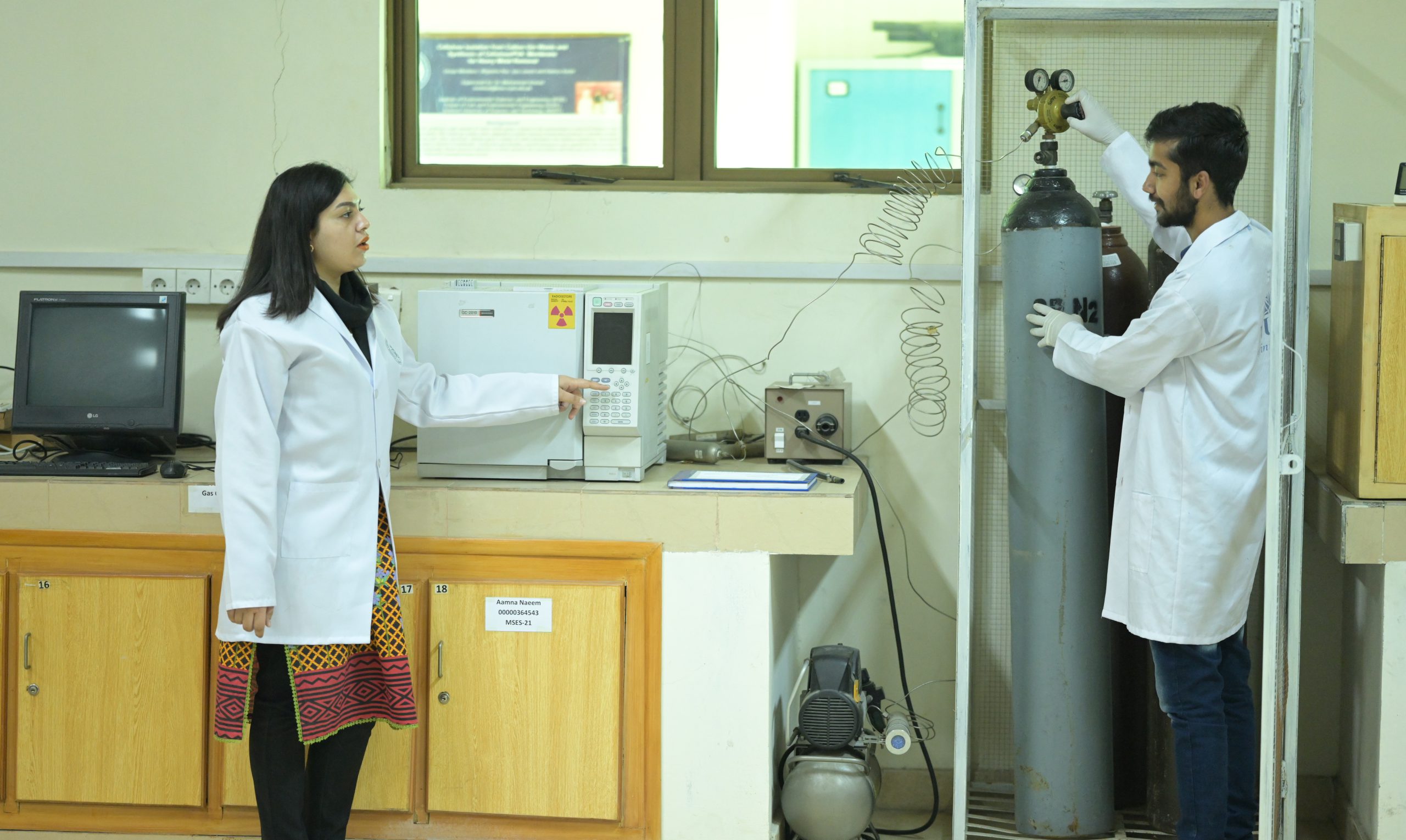
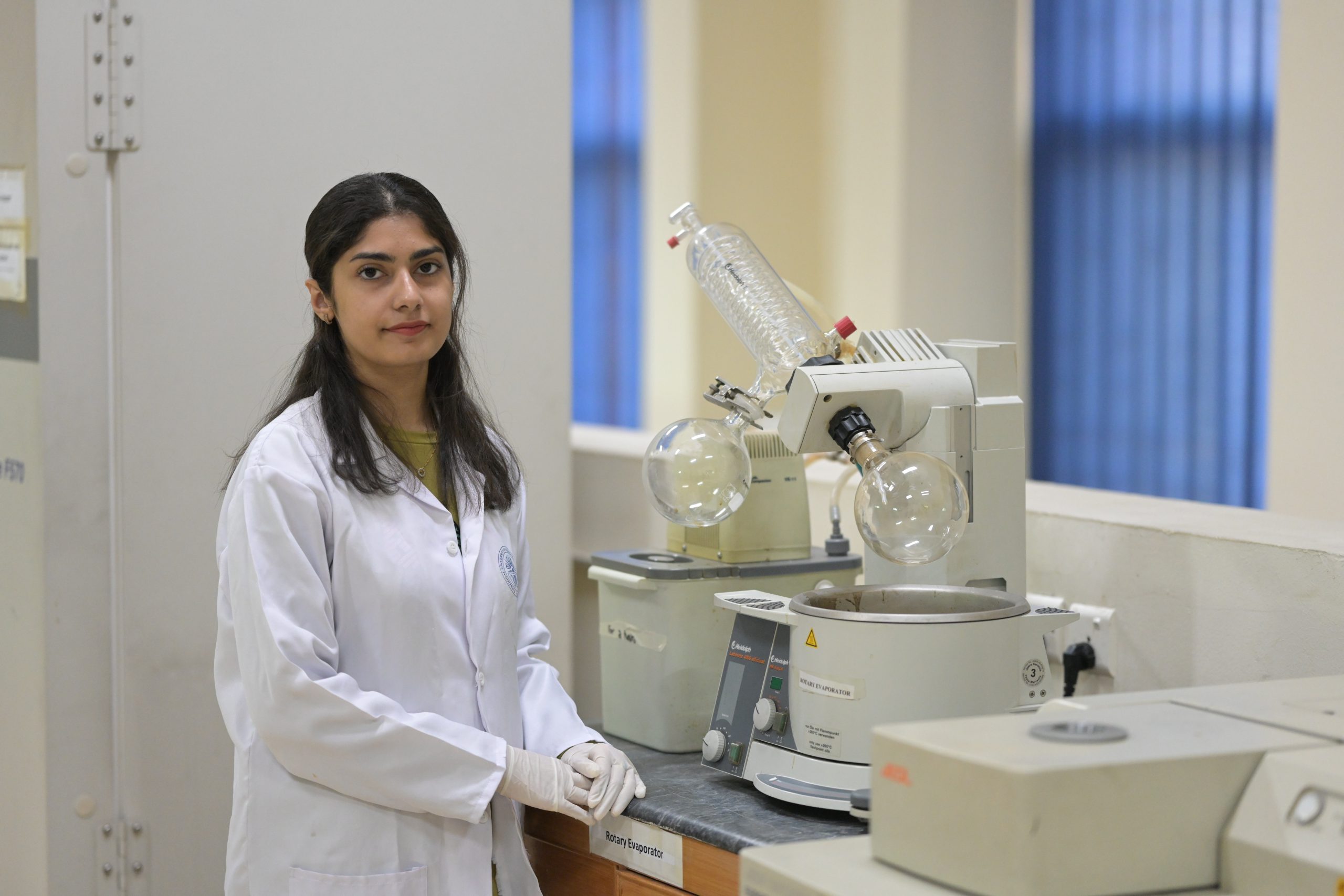
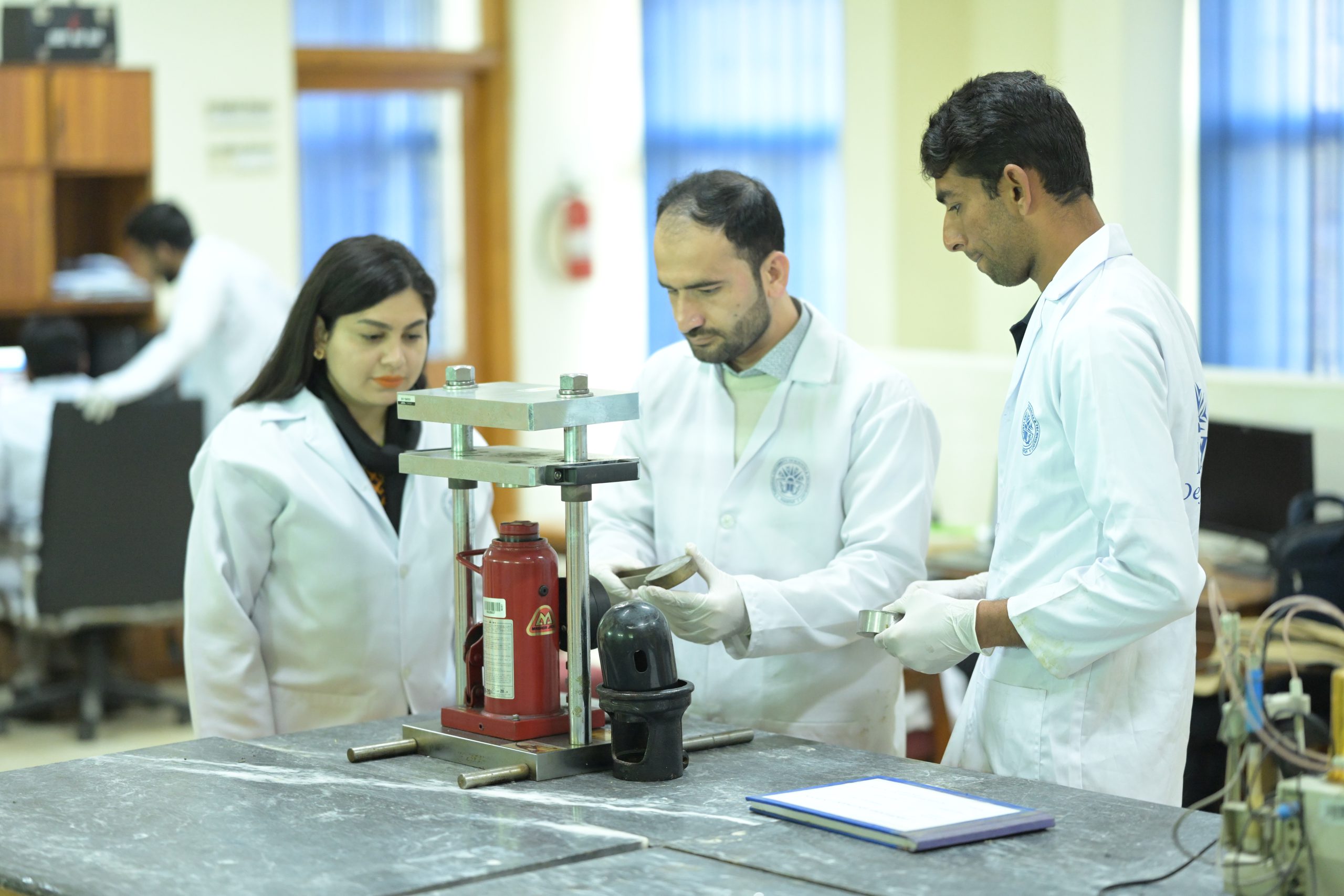
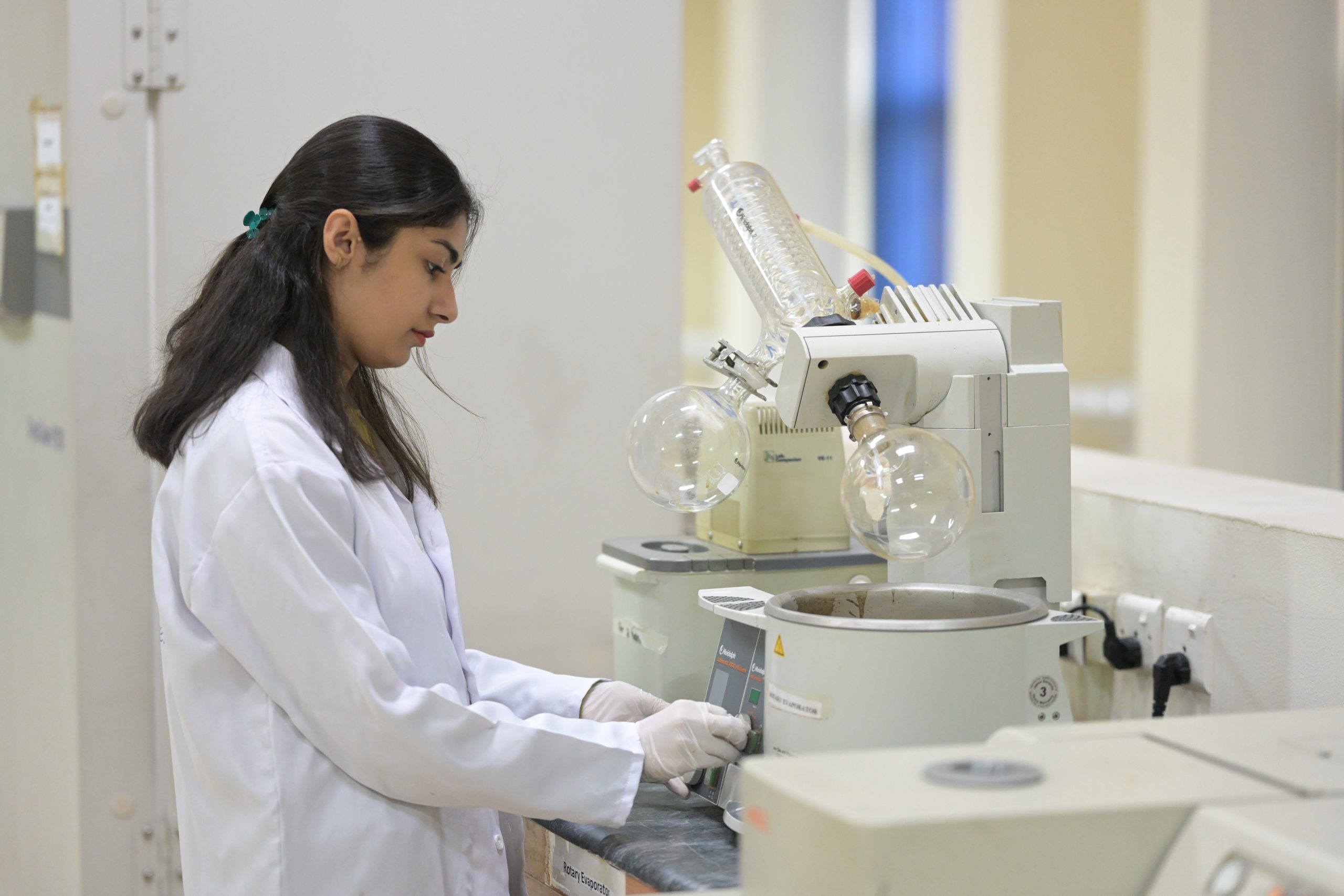

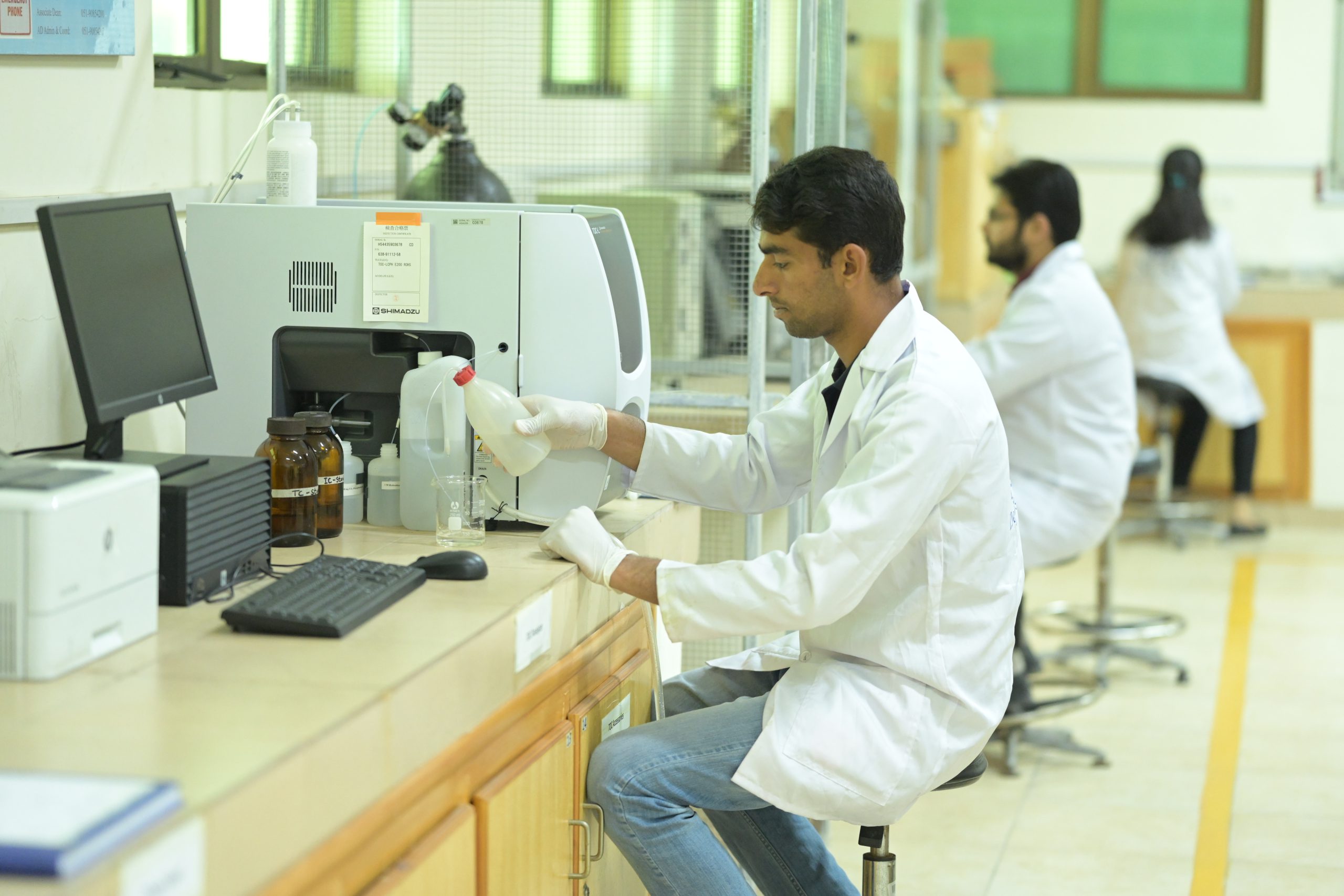
Lab Engineer
– Engr. Muhammad Uzair
– Email: [email protected]
– Contact: 05190854287
Introduction:
Water & Wastewater Treatment are the essential focus areas in Environmental Engineering. Water has been extensively used in different activities and then wasted. There is very little consideration regarding treatment and reuse of this water. Our lab has been established with the aim to study different technologies for Water & Wastewater treatment and propose for the better option. After enough research on MBRs, we were able to establish an MBR plant here at NUST for domestic Wastewater Treatment. Research students study different techniques like Membrane Bioreactor, Anaerobic Digestion, and Membrane Distillation etc.
Equipment List:
- Atomic Absorption Spectrophotometer
- Muffle Furnace
- Centrifuge
- COD Reactor
- Distillation Apparatus
- Kjeldahl Apparatus
- Oven
Available Parameters:
- Ammonium
- Chemical Oxygen Demand
- Chlorides
- Dissolved Oxygen
- Electrical Conductivity
- Nitrate
- Nitrite
- Oil and Grease
- Ortho-Phosphate
- pH
- Residual Chlorine
- Sludge Volume Index
- Sulfate
- Total Alkalinity
- Total Dissolved Solids
- Total Hardness
- Total Kjeldahl Nitrogen
- Total Phophorus
- Total Solids
- Total Suspended Solids
- Turbidity
Completed/Current Research Activities:
- Membrane Bioreactor for Domestic Wastewater Treatment
- Upflow Anaerobic Sludge Blanket Reactor for Textile Wastewater Treatment
- Performance evaluation of Anaerobic MBR using FO Concentrate
- Biofouling reduction in Electrocoagulation integrated MBR using Quorum Quenching technique
- Bio-solar Reactor for Pond water Treatment
- Membrane Distillation for Desalination of Brackish water
- Capacitive Deionization for Desalination of Brackish Ground water
- Arsenic & Hardness Removal by Ion-Exchange Membrane
- Development of Titania nano particle tape for decontamination of shopping cart handles
- Development of Titania coatings to enhance corrosion resistance.
Gallery:
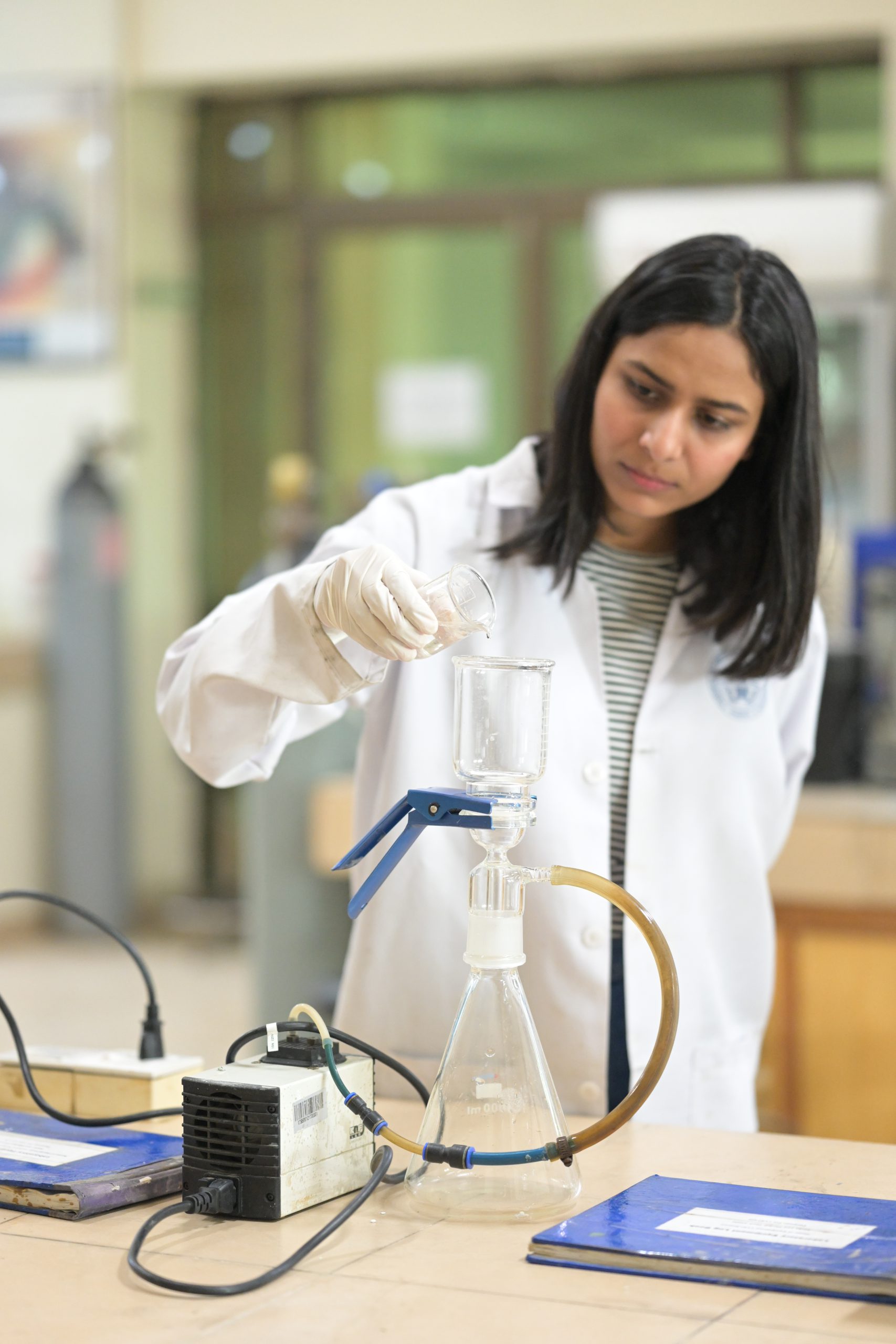
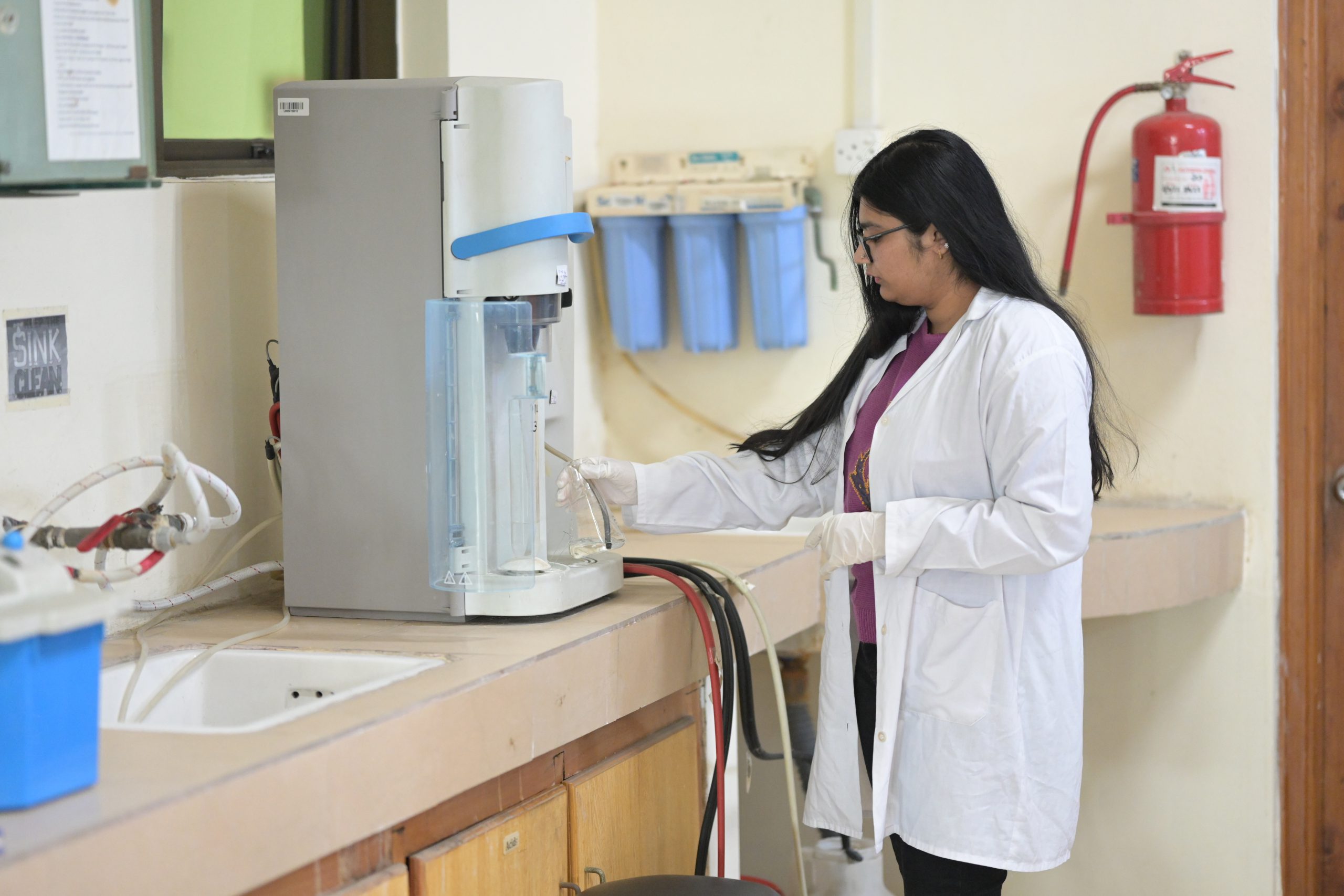
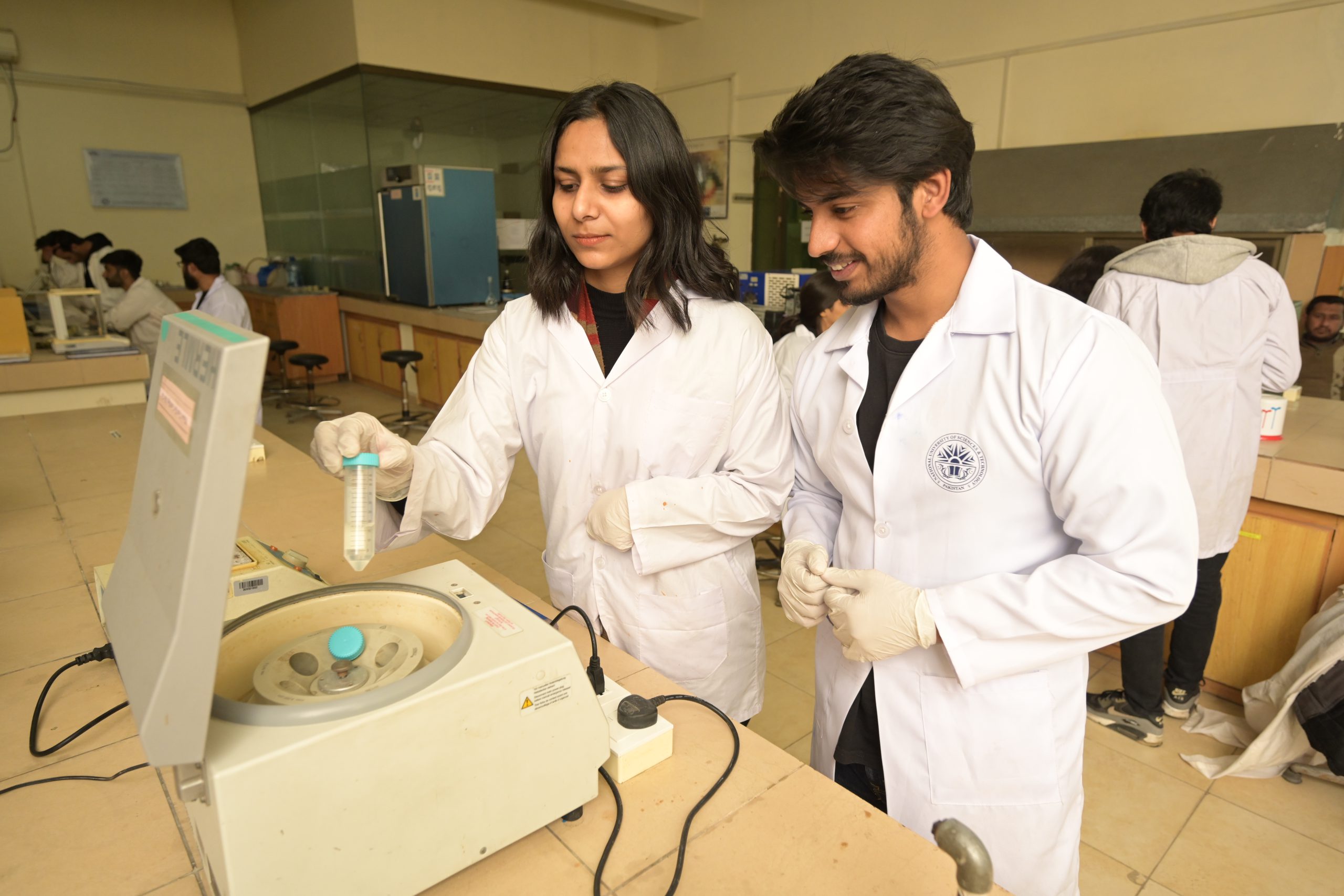

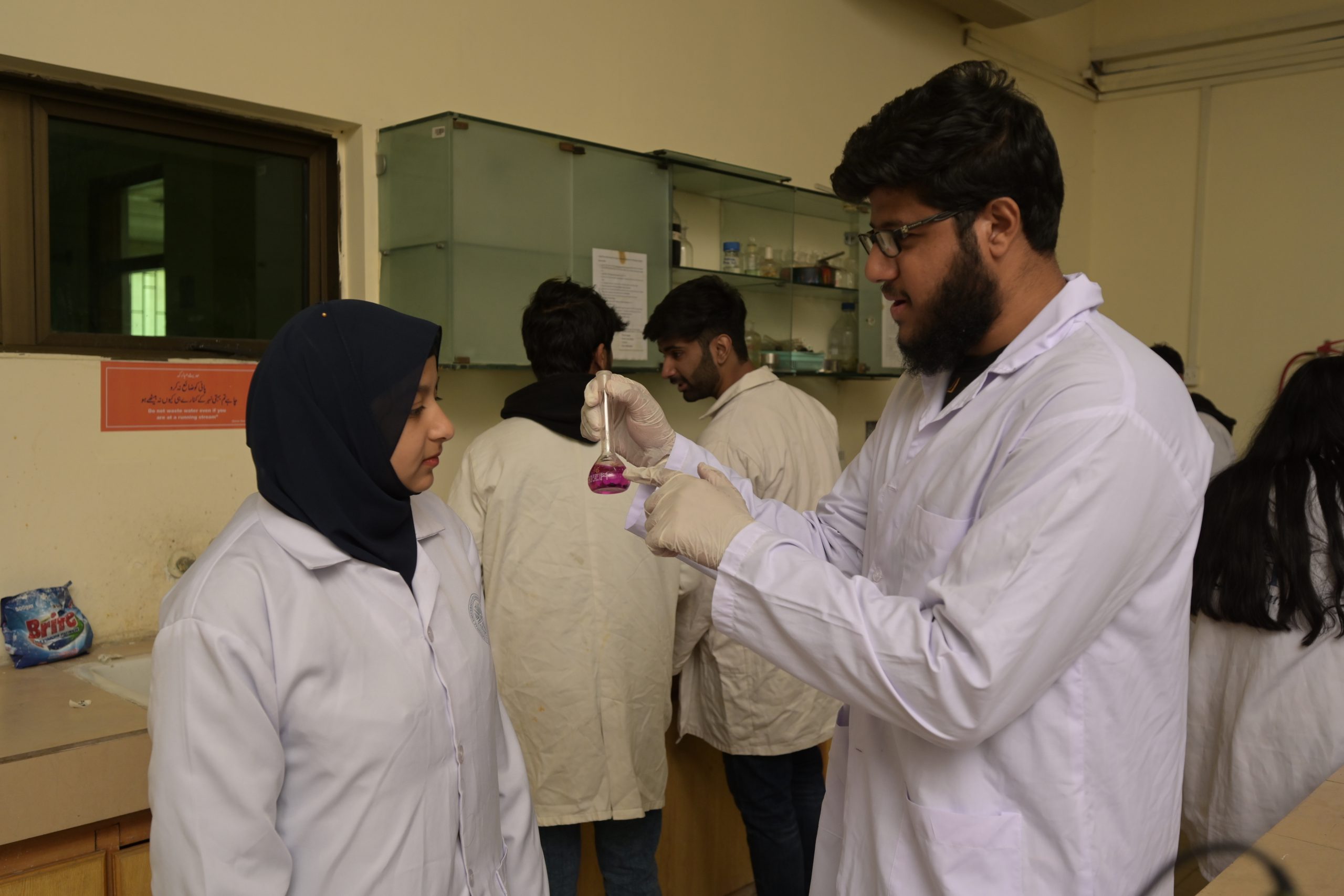
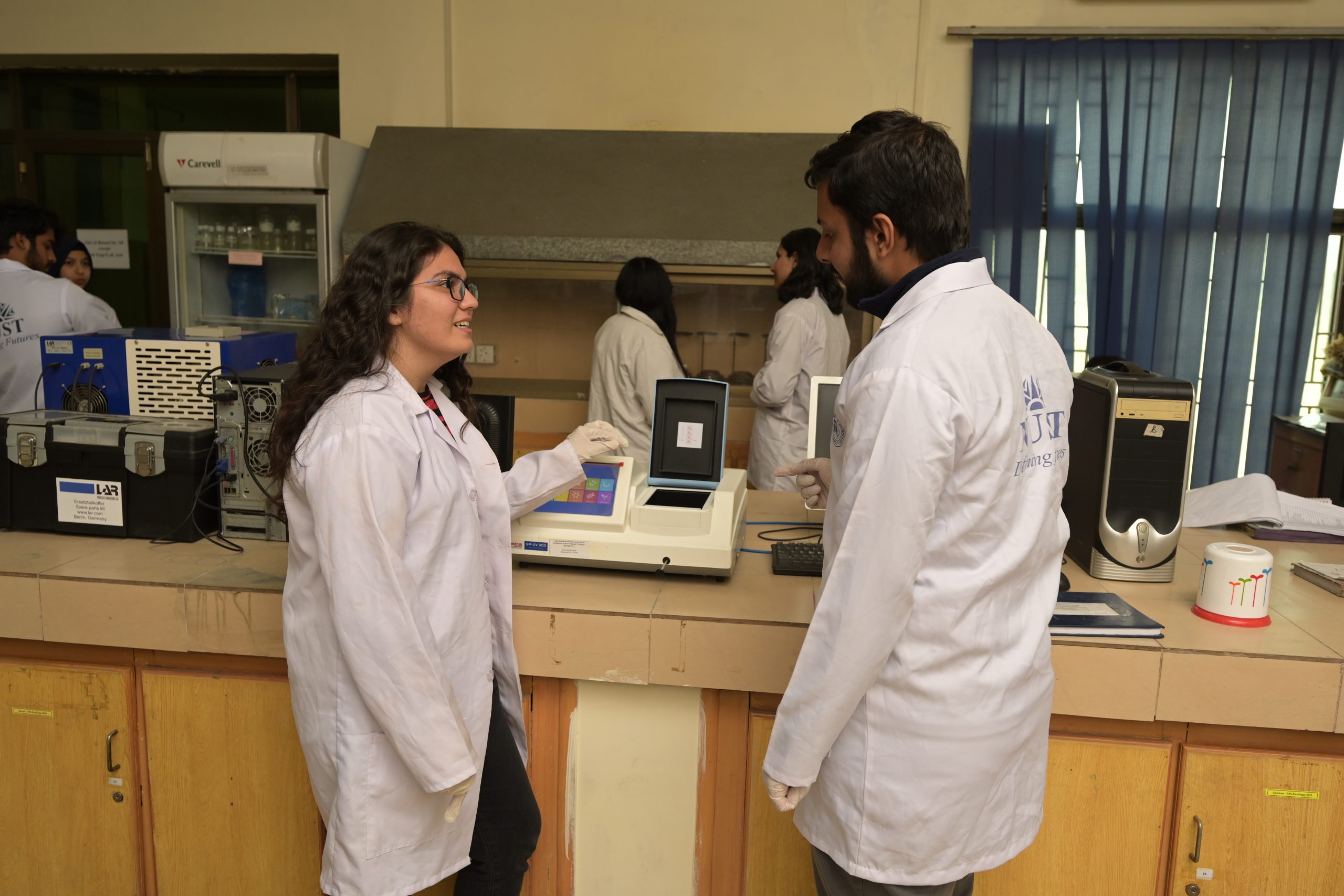
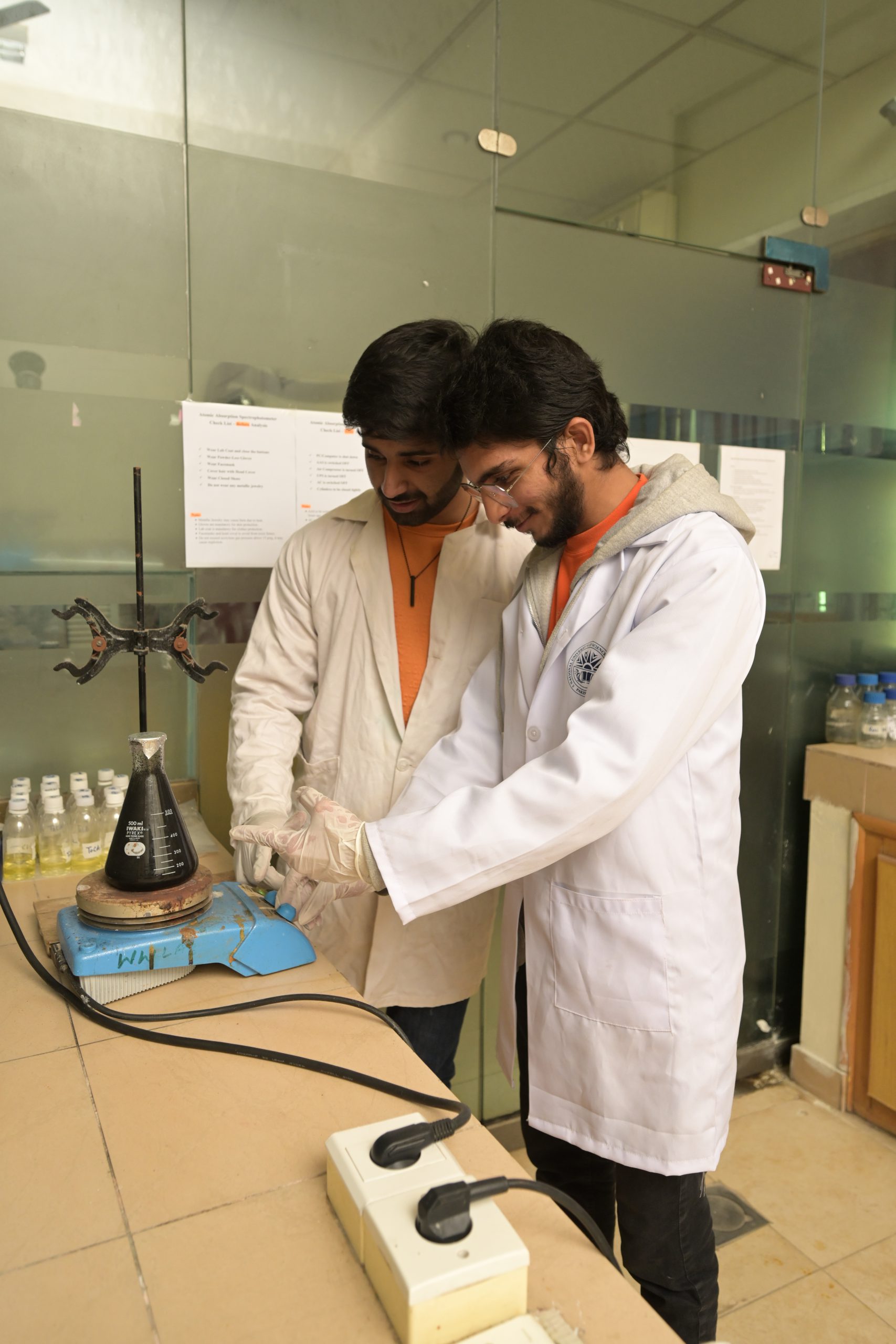
Lab Demonstrator
– Miss Romana Khan
– Email: [email protected]
– Contact: 05190854289
Introduction
In order to conduct experiments to investigate man-made poisonous chemicals and their effects on the aquatic life, “Environmental Toxicology Lab” was established at Institute of Environmental Sciences and Engineering (IESE) in July, 2015. Chemical as well as bio-monitoring approaches are being used to study the effect of chemicals, natural water, pollutants, and wastes on aquatic and terrestrial lives.
Available parameters
- Ammonia in water
- Biochemical parameters measured in body fluids such as:
-
- Glucose
- Total protein
- Triglycerides
- Alanine aminotransferase
- Urea
- Uric acid
- Bilirubin
- Creatinine
Experimental Tanks
Toxicity of Chloroform and Idoform
Toxicity of Idoform (CHI3) along with highly abundant trihalomethane, {Chloroform (CHCl3)} was determined in the present study. Young specimens (five fishes per batch) were exposed to control and experimental basin and mortality was observed against applied doses to identified LD50 for (24, 48, 72 and 96 hrs.) of exposure duration. At 96 hrs. the observed LD50 is 90 mg/L and 3 mg/L for chloroform and iodoform respectively. After identification of LD50 acute toxicity was measured by applying single-cell gel electrophoresis (Comet Assay) under Fluorescent Microscope (Optika- B353FL).

WATER DISTRIBUTION NETWORK OF NUST
In this research project spiking of 3 out of 5 microbial species in consortium to the prototype distribution network is used to analyze the potential at varying disinfectant dose ( 1%, 10%, 50% V/V ) and contact times (10 sec, 1 min, 10 min). Dose and Ct optimization against individual species and in microbial consortium. Addition of precursors to simulate real distribution network conditions.
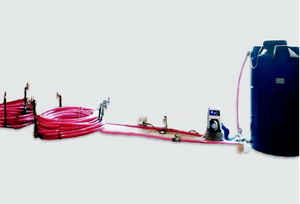
PRODUCTION OF BIO MASS BY USING CHLORELLA VULGARIS
In this research project the idea is to make micro-algal biomass production viable by designing advanced low cost photo bioreactor; requiring no additional land, minimal water use and mitigate atmospheric CO2. Porous Substrate Bioreactor (PSBR) uses a principle to separate the algae from a nutrient solution by means of a porous reactor surface on which the microalgae are trapped in biofilms.
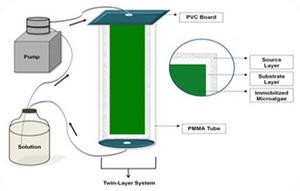
Major Tests
Kirby-Bauer Test
Kirby-Bauer test is used to measure antibiotic sensitivity. In Kirby-Bauer testing, bacteria are placed on a plate of solid growth medium and wafers of antibiotics (white disks, shown) are added to the plate. After allowing the bacteria to grow overnight, areas of clear media surrounding the disks indicate that the antibiotic inhibits bacterial growth. The concentration of antibiotic that diffuses into the media decreases with increasing distance from the source. Therefore, the more sensitive the bacteria are to a given antibiotic, the larger the clear bacteria-free zone that forms around the disk containing that antibiotic.

Disk Diffusion Test
The disk diffusion test is used to measure antibiotic sensitivity of bacteria. It uses antibiotic discs to test the extent to which bacteria are affected by those antibiotics. In this test, wafers containing antibiotics are placed on an agar plate where bacteria have been placed, and the plate is left to incubate. If an antibiotic stops the bacteria from growing or kills the bacteria, there will be an area around the wafer where the bacteria have not grown enough to be visible. This is called a zone of inhibition.

Gallery:




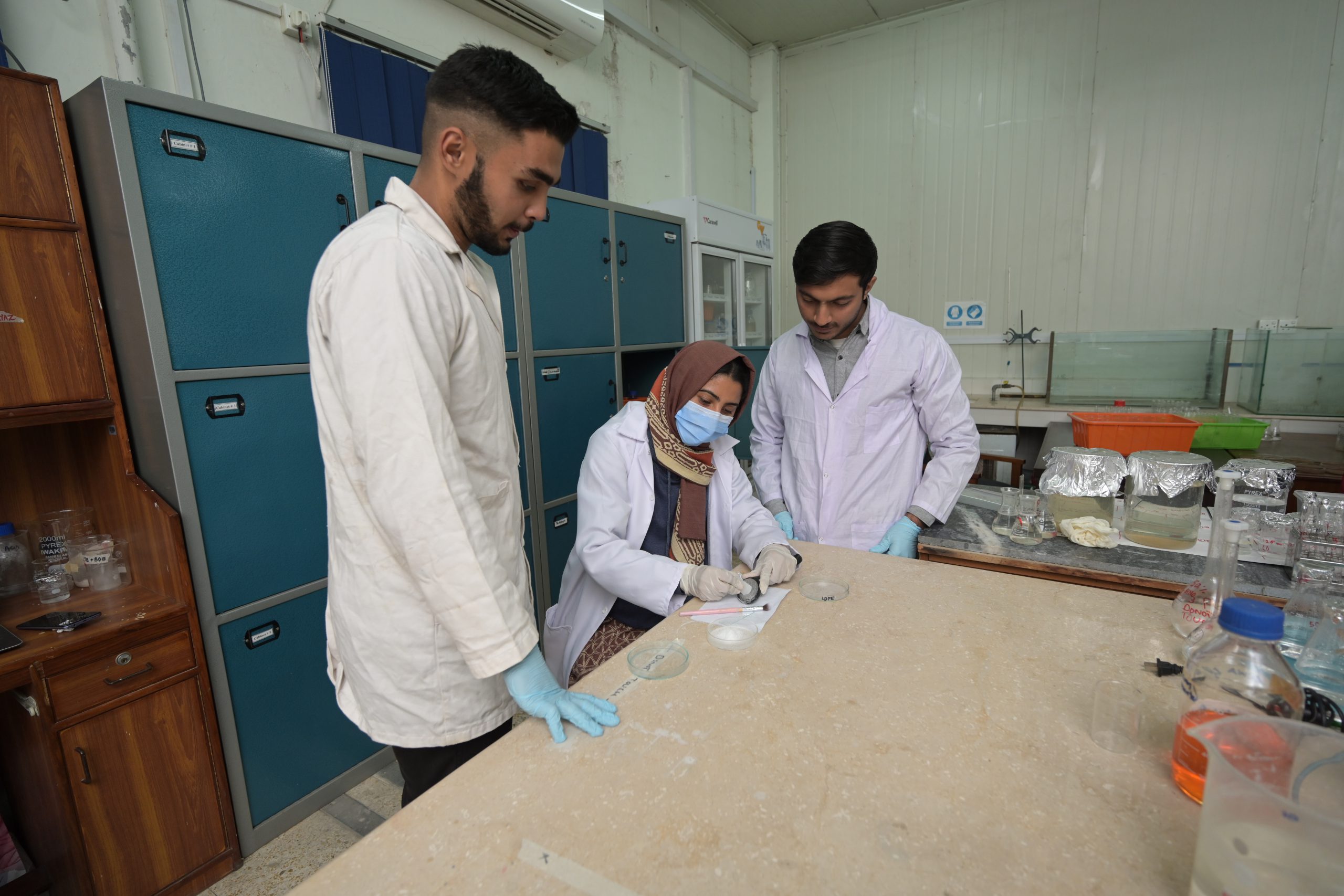
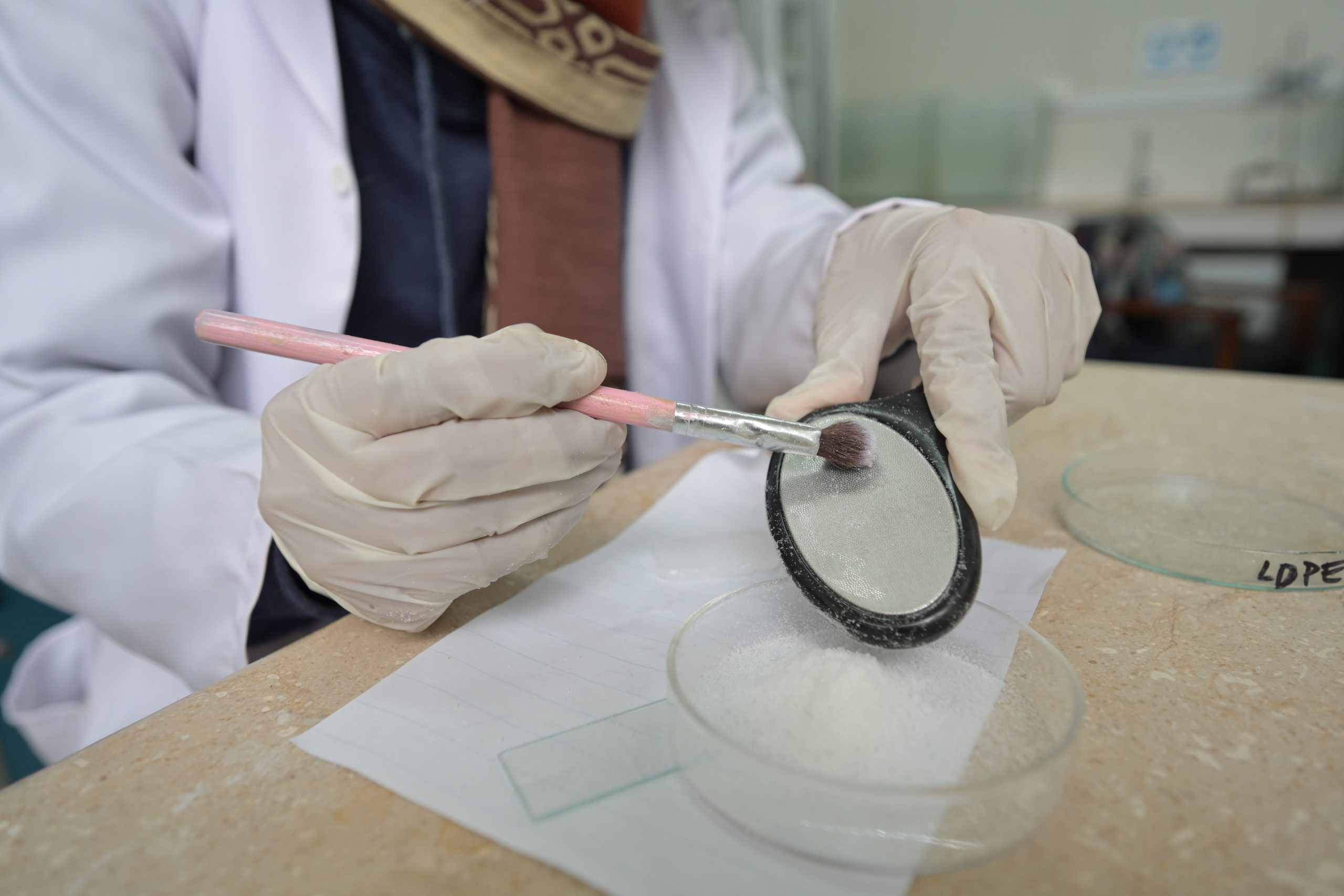

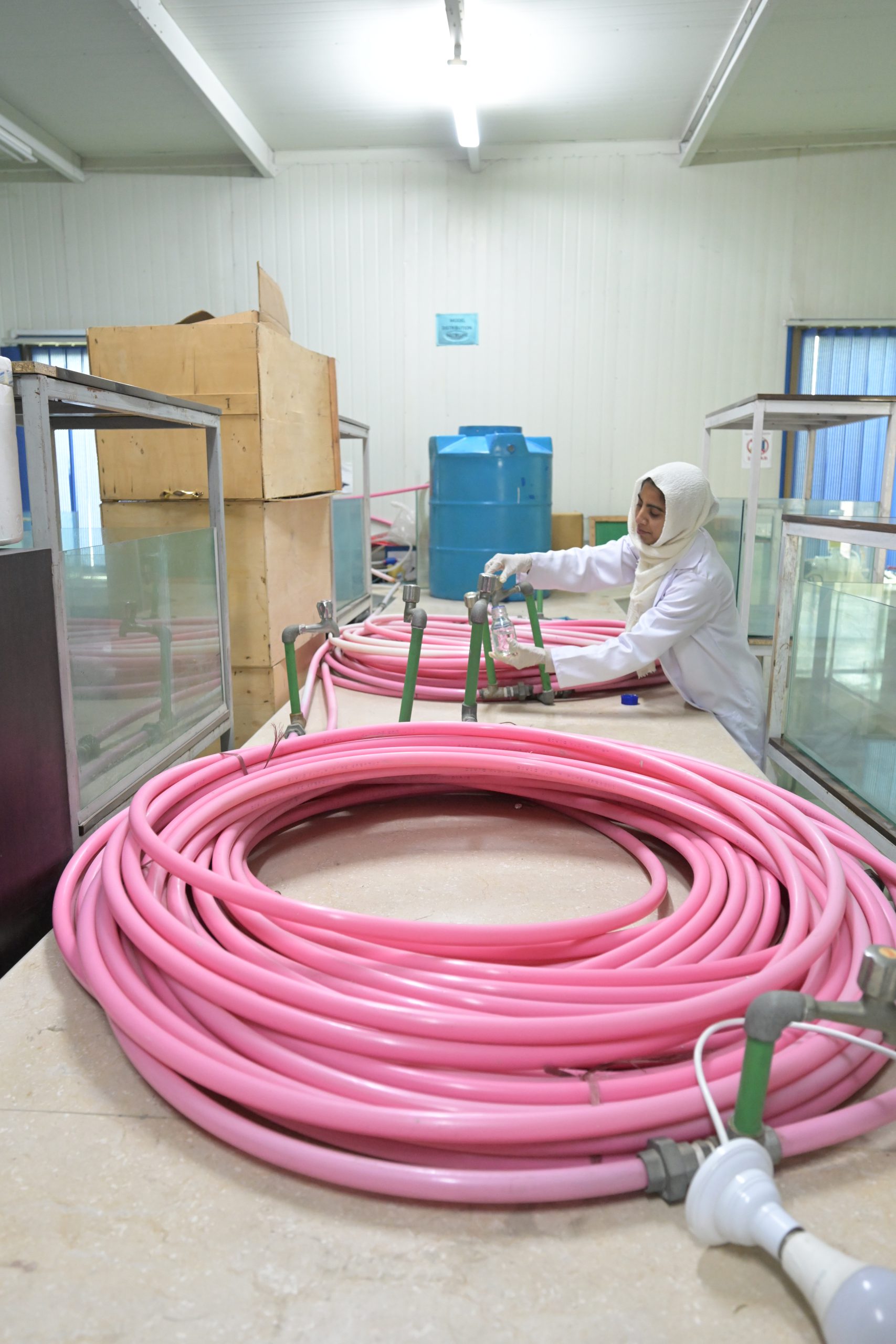
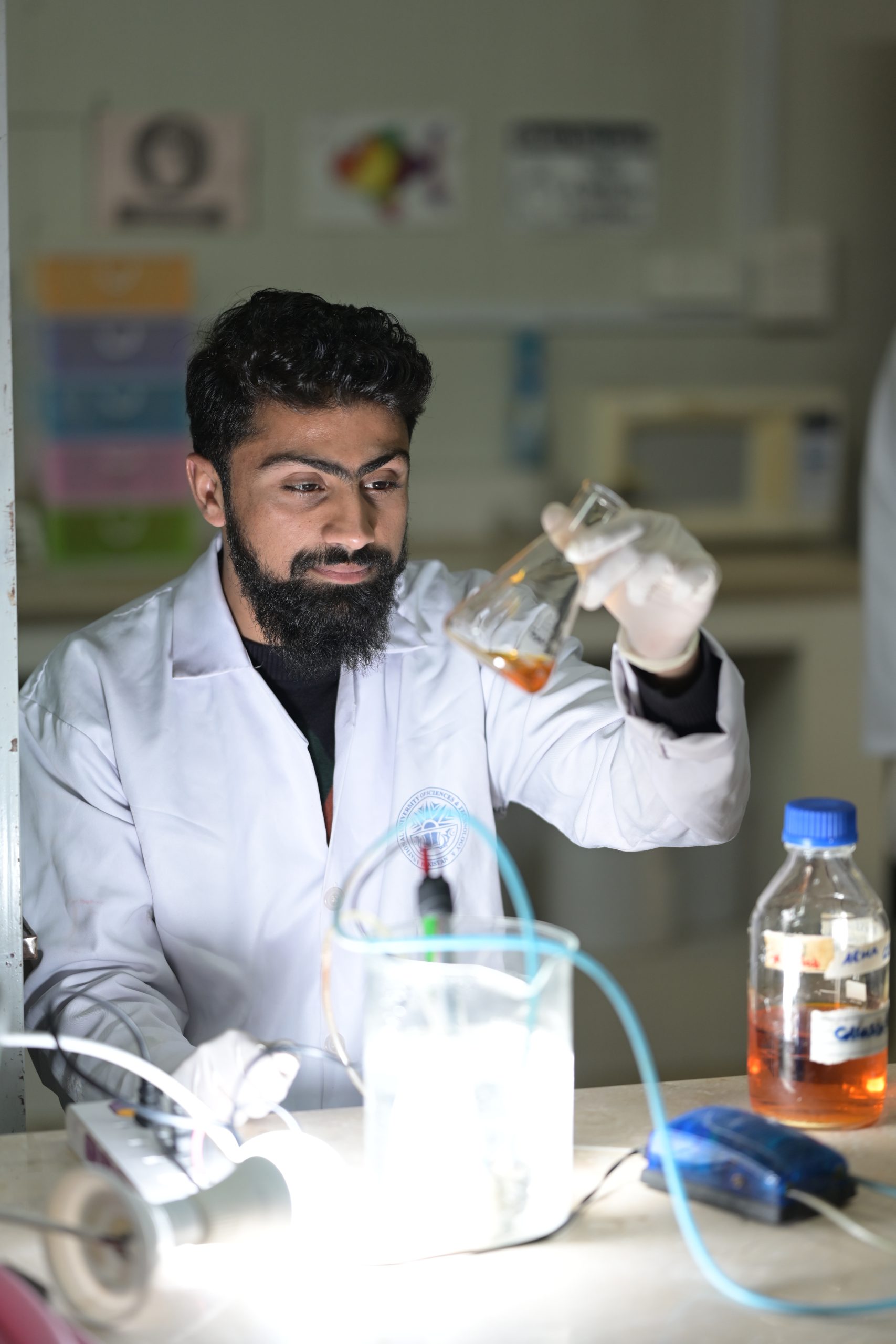
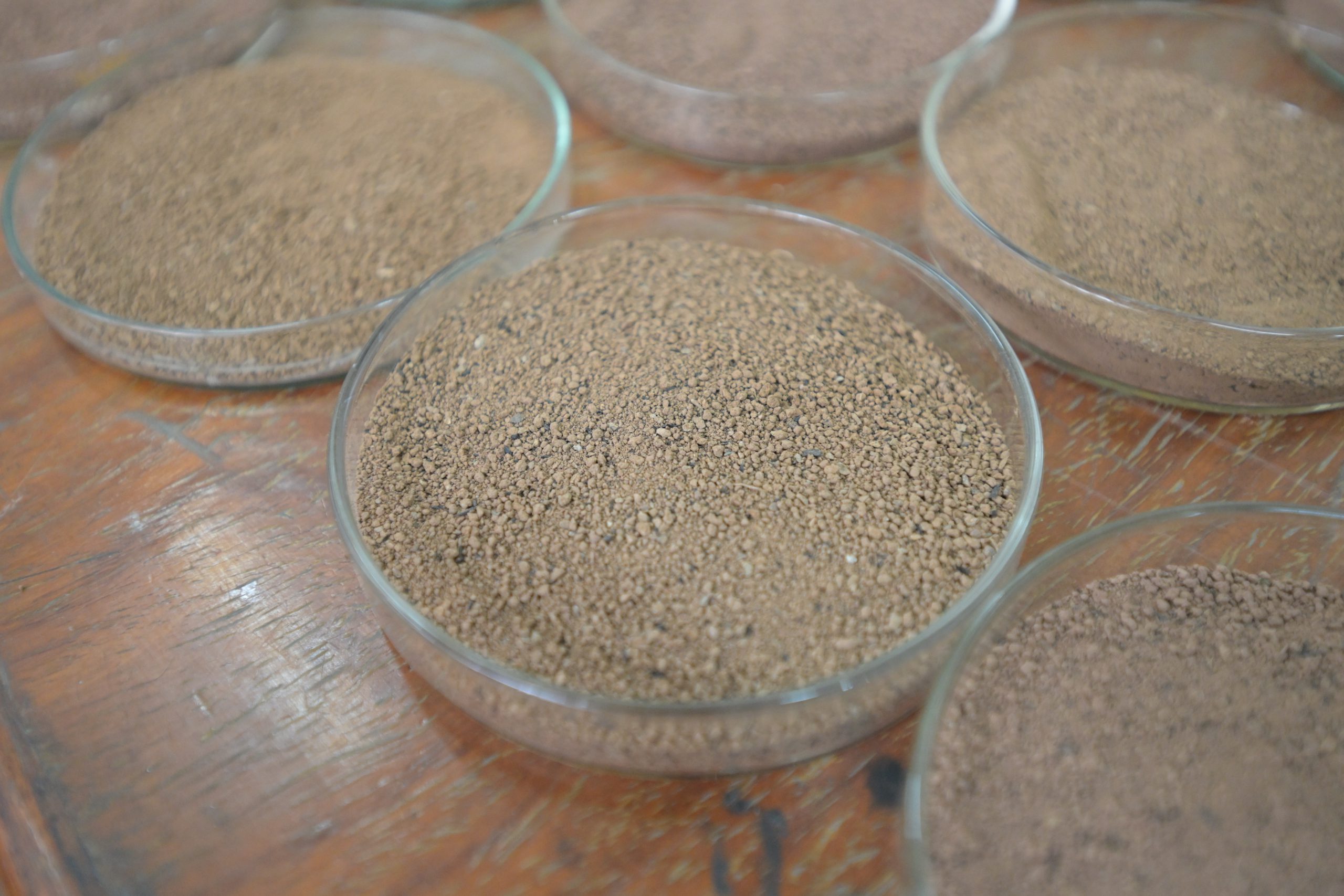
Lab Engineer
– Engr. Muhammad Irfan
– Email: [email protected]
– Contact: 05190854282
Introduction
The Environmental Chemistry Teaching Laboratory (ECTL) provides teaching and research capacity in the areas of analytical and environmental chemistry. Scientists identify and measure concentrations of toxic chemicals in many different media including air, water, soil, hazardous waste streams, and biological or human tissues. These efforts require the application or adaptation of existing procedures as well as the development of new analytical methods when required. The cycling of chemical species, the effect of man-made inputs, and environmental analytical methodology are stressed. This laboratory is active in several research areas including emerging contaminants, advanced analytical techniques, and conventional and novel physical-chemical treatment processes for water and waste systems.
Available parameters
- Water and wastewater parameters
-
- Alkalinity
- Ammonia Nitrogen
- Biochemical Oxygen Demand (BOD)
- Chemical Oxygen Demand (COD)
- Chlorides
- Conductivity
- Fluoride (F-1)
- Hardness
- Nitrate-Nitrogen
- Nitrite
- Optimum Coagulant Dose
- pH
- Phosphate-Phosphorus
- Sulfate (SO42-)
- Sulfide (S-2)
- Total Chlorine
- Total Dissolved Solids (TDS)
- Total Kjeldahl Nitrogen (TKN)
- Total Suspended Solids (TSS)
- Turbidity
- Volatile Solids (VS)
- Volatile Suspended Solids (VSS)
- Compost, Solid Waste, Sludge, and Digestate
-
- pH
- Total Solids (TS)
- Volatile Solids (VS)
- Organic Carbon
- Nitrate-Nitrogen
- Phosphate-Phosphorus
- Nitrite
- Total Kjeldahl Nitrogen (TKN)
- Ammonia Nitrogen (NH4+ – N)
Research projects
- Biogas production through dry anaerobic digestion of organic solid waste.
- Development of Titania Nanoparticle coated tape for decontamination of shopping cart handles.
- Improving NUST’s lake water quality for potable use.
- Phosphorus removal in Wastewater: A Comparison between Biological v/s Physico-Chemical Processes.
- Up flow Anaerobic Sludge Blanket Reactor in continuous and intermittent operation treating Textile Wastewater
- Development of photodegradable polyethylene films for food packaging to increase shelf life of food.
- Phenolic spent caustic degradation in flat bed photoreactor using TiO2 nanoparticle immobilized on polystyrene beads.
- Determination of phototoxicity in rice in response to nanoparticle and their impact on animal model
- Anaerobic digestion of high strength wastewater of distillery and by-products of sugar cane industry to enhance energy balance
- High Solids Anaerobic Digestion of Sewage Sludge
- Anaerobic Digestion of Pre-treated Sludge in Pilot Scale Reactor
- Anaerobic Digestion of High Strength Wastewater from the Distillery and By-products from Sugarcane Industry to Enhance Energy Balance
| UV-Vis Spectrophotometer
A spectrophotometer is commonly used for the measurement of transmittance or reflectance of solutions. Tests like determination of Nitrate-Nitrogen (NO3-N), Sulfate (SO4-2), Phosphates, Silicates, Chlorides and Color are conducted on this instrument.
|
| Conductivity meter
A conductivity meter measures the conductivity in a given solution and is used for conductivity determination which a major test for determining water purity.
|
| Water bath
A water bath is a device used to incubate samples in water maintained at a constant temperature. Temperature may be controlled digitally or by a dial and once set, the water bath cycles on and off to ensure constancy of the temperature. It is mostly used in determination of Total Solids, Total Suspended Solids and Total Dissolved Solids.
|
| Incubator
An incubator is a device used to grow and maintain microbiological cultures or cell cultures. The incubator maintains optimal temperature, humidity and other conditions such as the carbon dioxide (CO2) and oxygen content of the atmosphere inside. It is used in determining the Biological Oxygen Demand (BOD) of samples.
|
| Turbidimeter
Turbidity is one of the most commonly used parameters for determining the quality of water. The turbidity value is an important factor in various fields of application such as drinking water, disinfection processes, industrial processes and water treatment plants. It is used in determination of turbidity by nephelometric method.
|
| Oven
An oven is used in sterilization, experiment management, drying, processing, and testing. Mostly used in TDS, TSS and TS determination.
|
| pH meter
It is used to measure hydrogen-ion activity (acidity or alkalinity) in a solution. Mostly used for pH determination in a wide range of experiments.
|
| Vacuum Filtration Assembly with pump
Vacuum filtration Assembly is used for separating a solid product from a solvent or liquid reaction mixture. The mixture of solid and liquid is poured through a filter paper in a Buchner funnel. It is widely used in determination of Total Dissolved Solids and MLSS.
|
| BOD Trak Apparatus
BOD analysis (Biochemical Oxygen Demand) is a chemical procedure for determining the amount of dissolved oxygen consumed by aerobic biological microorganisms in water. BOD analysis is carried out on a given water sample at certain temperature over a specific period. The BOD Trak apparatus features easy set-up, quick sample preparations, no titration dilutions. This unit gives results directly in mg/l. Mostly used in BOD determination.
|
| Six Paddle Stands Jar Testing Apparatus The Jar test is a common laboratory procedure used to determine the optimum operating conditions for water or wastewater treatment. Mostly used in determining optimum coagulant dose and chemical requirements for water softening.
|
| Electronic Analytical Balance It is used in a wide range of experiments for chemicals measuring and solution preparation.
|
| Hot Plate Stirrer Hot plate stirrers are widely used instruments for numerous applications. Moreover, homogenous mixing can be achieved by this instrument.
|
Gallery:

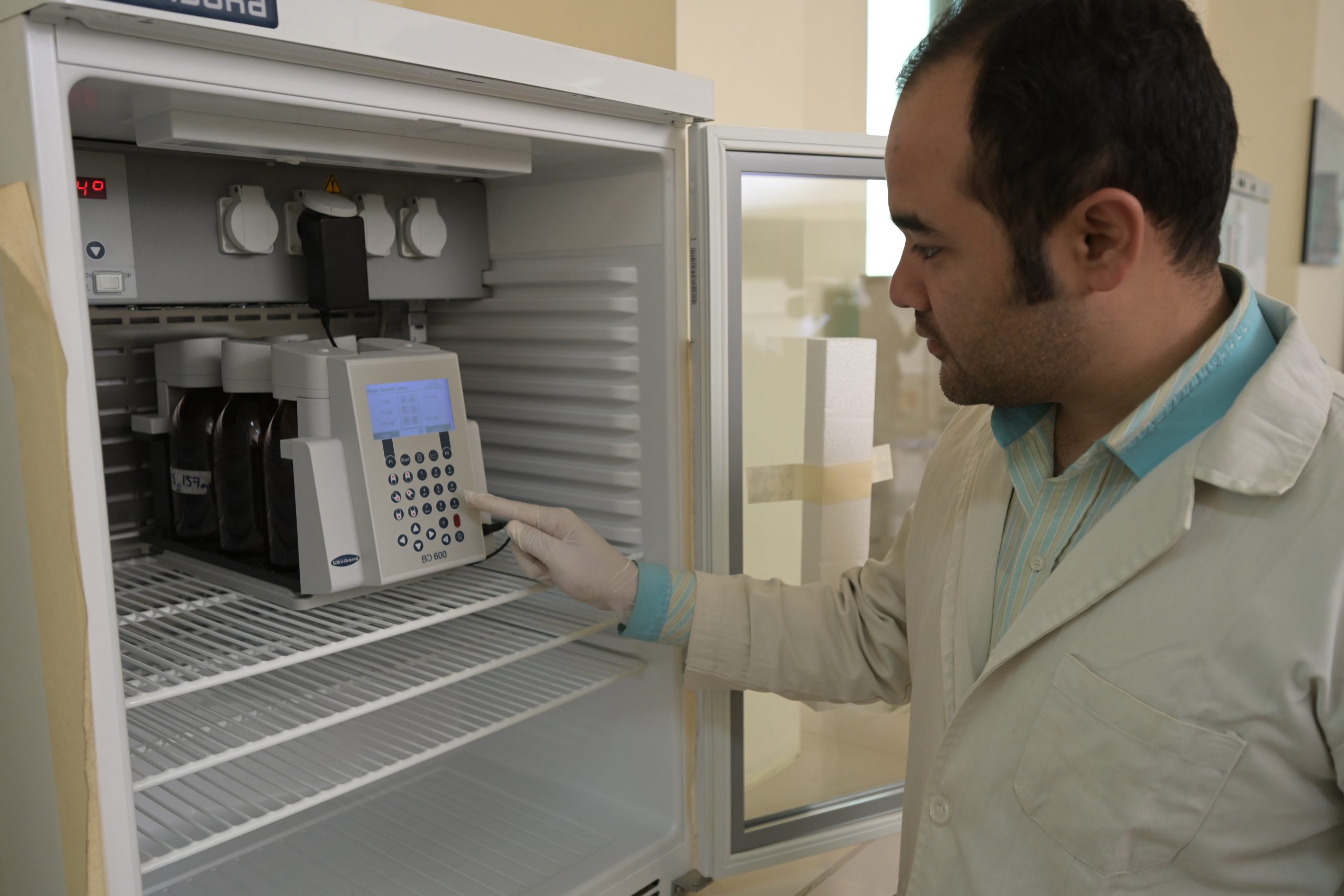
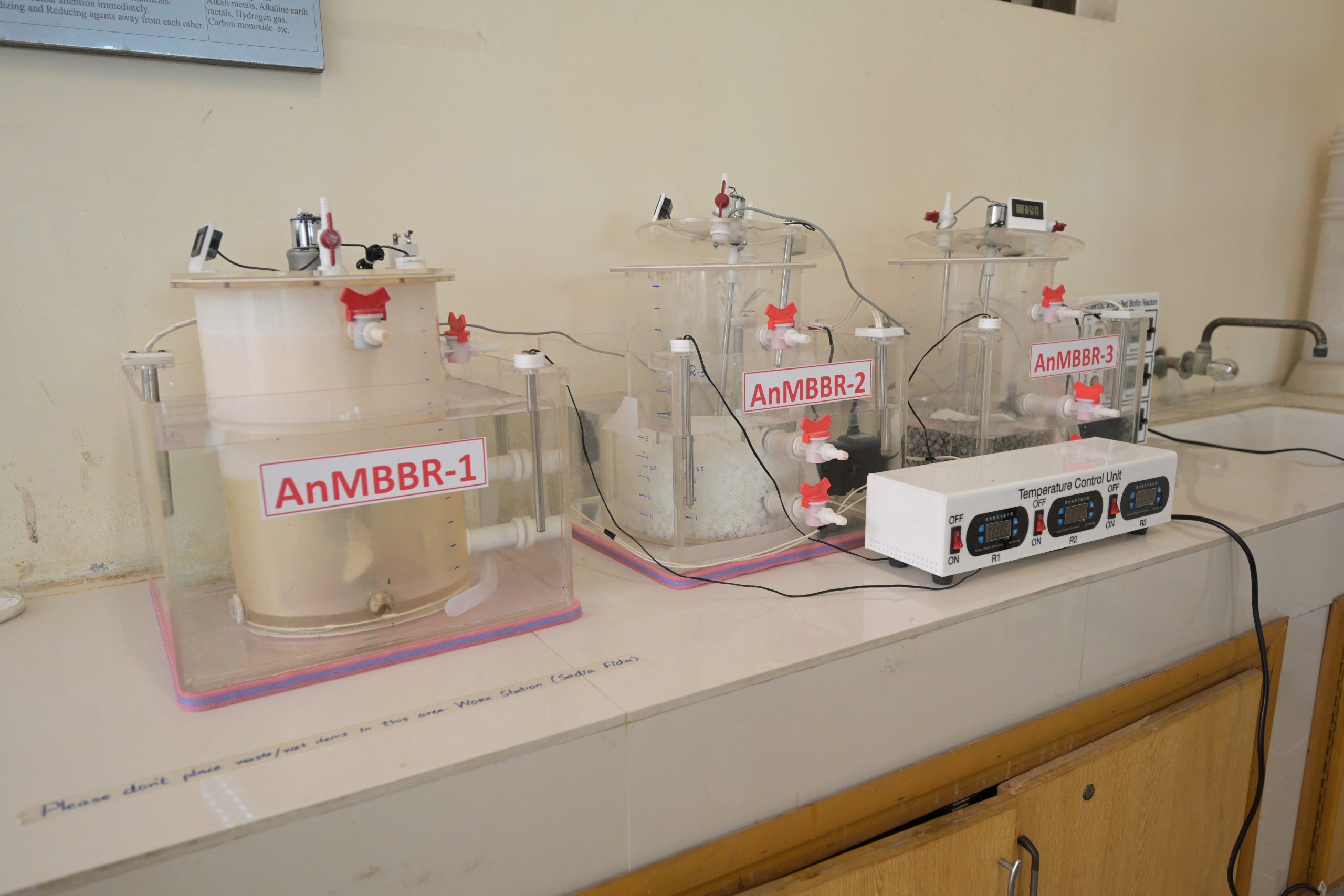
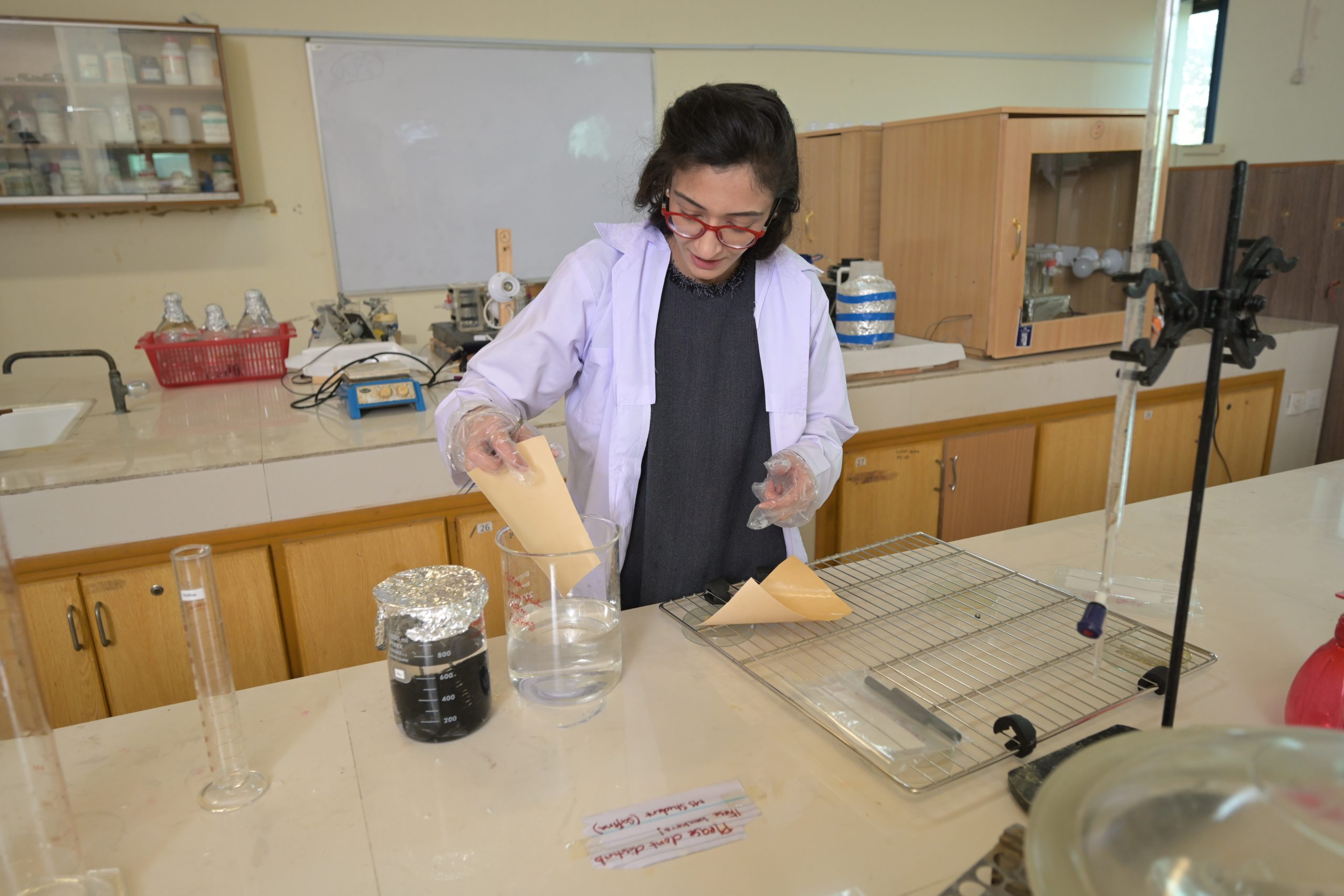
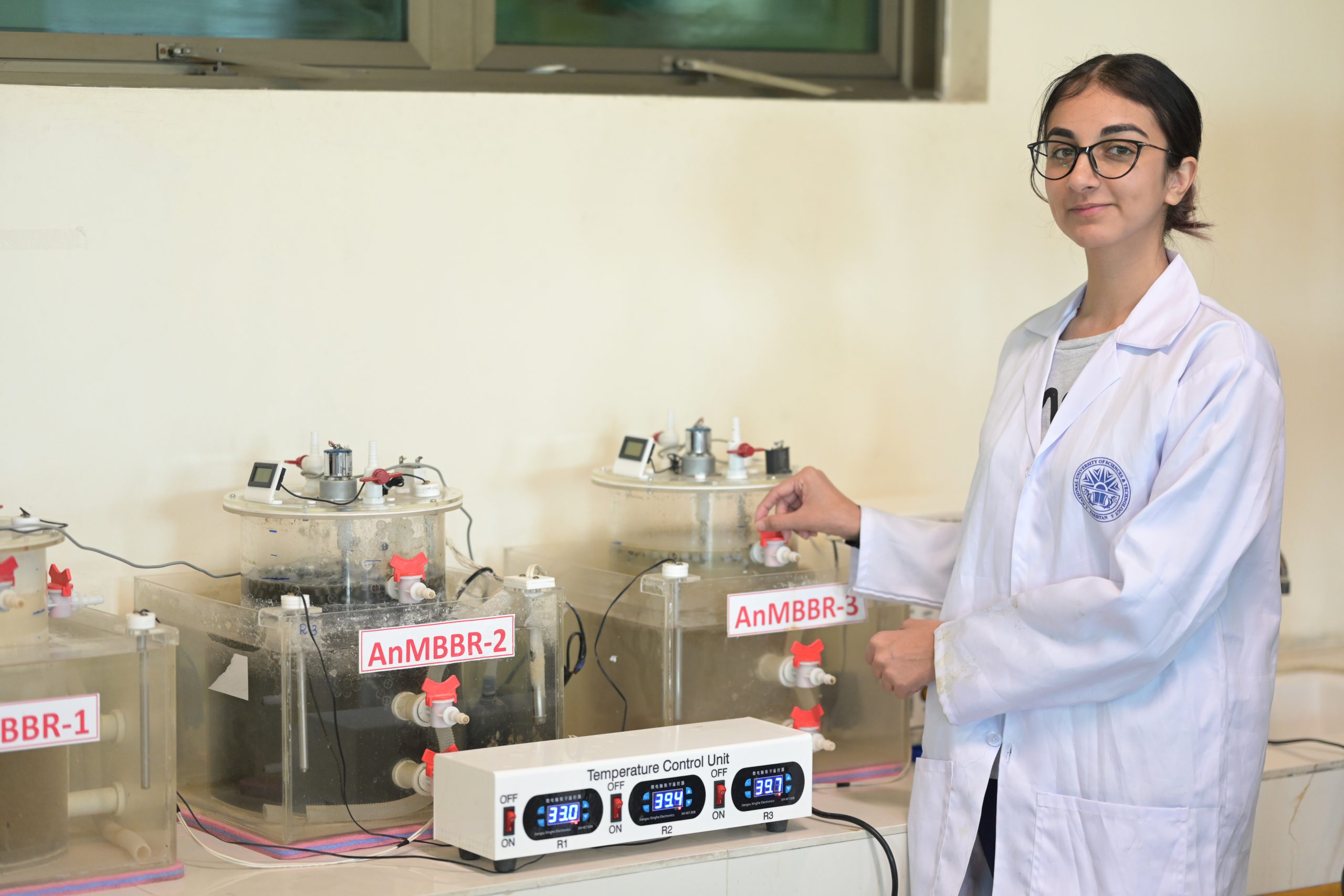
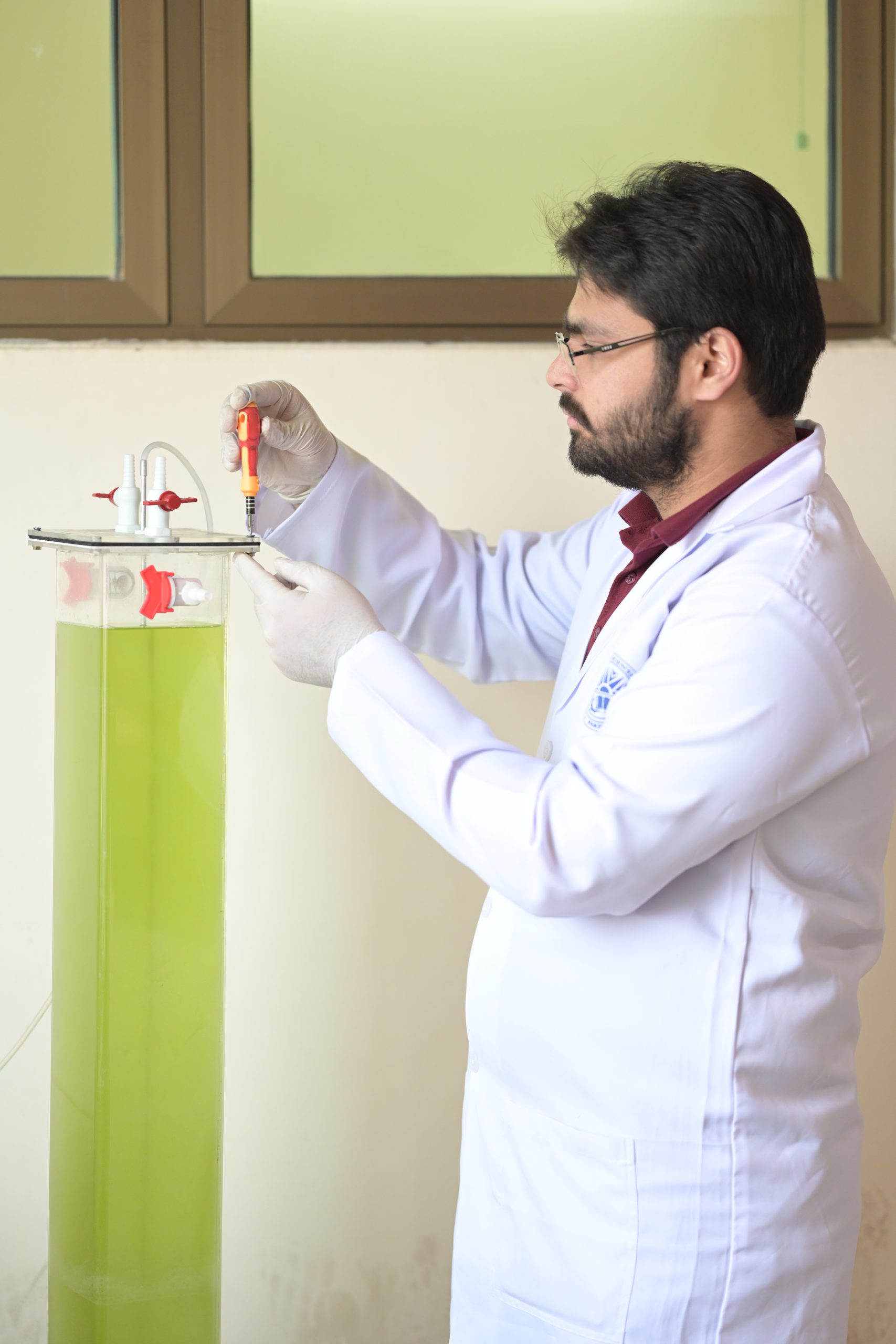
Lab Demonstrator
– Miss Mehwish Khalid
– Email: [email protected]
– Contact: 05190854288
Introduction:
In order to conduct Microbial analysis of all environmental samples at Institute of Environmental Sciences and Engineering (IESE), Environmental Microbiology Teaching Lab was established in 2005.
Research activities in the Environmental microbiology teaching lab are divided between teaching basic microbiology experiments to the undergrad and providing full state-of-art equipment and lab infra-structure for conducting MS and PhD level research. The sophisticated instrumentation in lab needs proper care and precautionary measures. Keeping this in view all the research students are advised to follow the set of instructions.
Major Tests
- Bacteriological examination of water by MF Technique
- Microbiological Monitoring of Air and water Quality
- Effect of Temperature on Growth of Microorganisms
- Study of the Algal population of waste stabilization ponds
- Enumeration of Soil Microorganisms
- Identification of bacterial species
- Genotoxicity of Chlorine by-products
- Biodegradation studies
- PCR and gene sequencing
- Testing of erythrocyte nuclear abnormalities
- Enumeration of helminthes eggs and parasitic worms
- Translocation pf microorganisms in plants
- Enumeration of entophytes
- Quorum sensing
Available parameters
- Biochemical tests (Oxidase, Catalase)
- “Detection/Isolation/Quantification of
E.coli
Salmonella
Shigella
Bacillus
Pseudomonas” - Electrical Conductivity
- Motility
- Optical Density
- pH
- Total phosphorous
Microbial Water Quality Analysis
The testing is precise, accurate and reliable due to the latest apparatus available in the lab in addition to the expertise of the staff. The entire equipment used in testing is regularly calibrated in order to maintain its accuracy.
- Standard Plate Count Test
- Standard Coliform
- Fecal Coliform
Major Equipment:
Gradient Thermal Cycler
It is used to amplify segments of DNA via the polymerase chain reaction (PCR). Thermal cyclers may also be used in laboratories to facilitate other temperature-sensitive reactions, including restriction enzyme digestion or rapid diagnostics
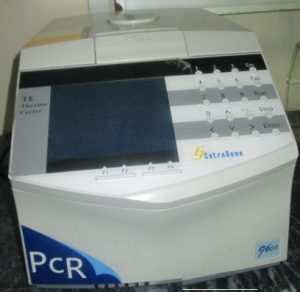
Gel Electrophoresis Horizontal
It is a method for separation and analysis of macromolecules (DNA, RNA and proteins) and their fragments, based on their size and charge.
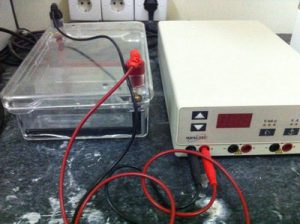
Gel Doc system
It is used in molecular biology laboratories for the imaging and documentation of nucleic acid and protein suspended within polyacrylamide or agarose gels.

Digital Autoclave
It is to sterilize equipment, glassware and media by subjecting them to high pressure saturated steam at 121 °C (249°F) for around 15–20 minutes depending on the size of the load and the contents.

Incubator (Adaptive multifunctional Digital PID Capacity) :
It is a heated, insulated box used to grow and maintain microbiological or cell cultures. The incubator maintains optimal temperature, humidity and gaseous content of the atmosphere inside.
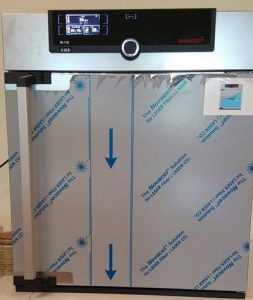
Portable UV/Vis Spectrophotometer
Purpose of this is to measure Optical density of a sample. It can measure intensity as a function of the light source wavelength
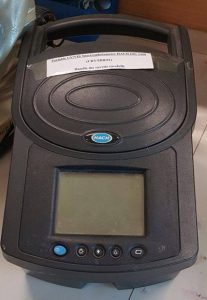
Laminar Flow Hood
Provide sterilize environment for microbial inoculations and culture handling.
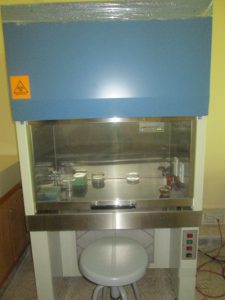
Refrigerated Micro centrifuge:
A microcentrifuge, is used to spin small (2 ml or less) liquid samples at high speeds. Centrifugation of small samples is important for many biological applications, such as pelleting nucleic acids for downstream application such as PCR and sequencing, or isolating proteins from solution for use in western blot or 2D electrophoresis. Refrigerated centrifuges protect sensitive samples from heat degeneration, protect the sample’s integrity.
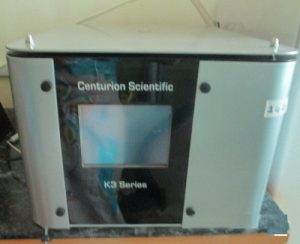
Ice Flaking Machine:
Ice flaking machine is conceptualized and designed to meet the continuous requirement of ice to store biological samples along with transportation to other facilities. It is made up of corrosion free metal components with advance insulation ensuring maximum thermal efficiency and durability.

Leica Microscope
An instrument used to observe objects that are too small for the naked eye. Light microscopes from Leica Microsystems are of high quality and meet the highest demands whatever the application – from routine laboratory work to the research of multi-dimensional dynamic processes in living cells.

Water Bath
It is a device for regulating the temperature of anything subjected to heat, by surrounding the vessel containing it with another vessel containing water which can be kept at a desired temperature.

DO meter:
Measures dissolved oxygen in wastewater, surface water and aquaculture applications. Calibrates easily in a saturated air environment and displays in % or ppm (mg/L) values.
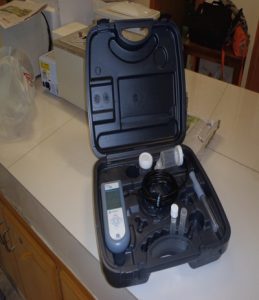
Colony counter
Petri plates are inserted inside the colony counter where they are properly lit and magnified. Operators can tick detected colonies with a specifically devised marker, meanwhile a digital display will increase the total counts.
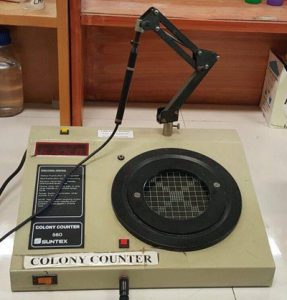
Orbital Shaker
It is used to blend or agitate samples within flasks or tubes. These shakers also provide convenience of programmable speed as well as running time with option of customizing its platform as per ones requirement and application.
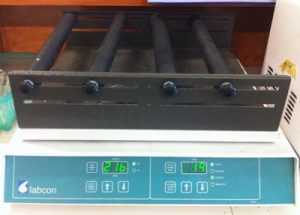
Gallery:
